
Marijuana
Impact on:
The Brain
The Body
The Future
1

Learning Objectives
Increase knowledge of the effects
of marijuana in the areas of:
• Impairment
• Health
• Future Success
• Addiction
• Perception of Harm
2

Marijuana:
The Basics
3

Marijuana Basics
Common Forms
• Marijuana is a green, brown, or gray mixture
of dried, shredded leaves, stems, seeds, and
flowers of the cannabis plant.
• Marijuana contains more than 400 chemicals.
• Buds have higher THC* content (the main
active chemical in marijuana.)
*Delta-9-Tetrahydrocannabinol – main psychoactive – mind altering chemical in
marijuana.
4
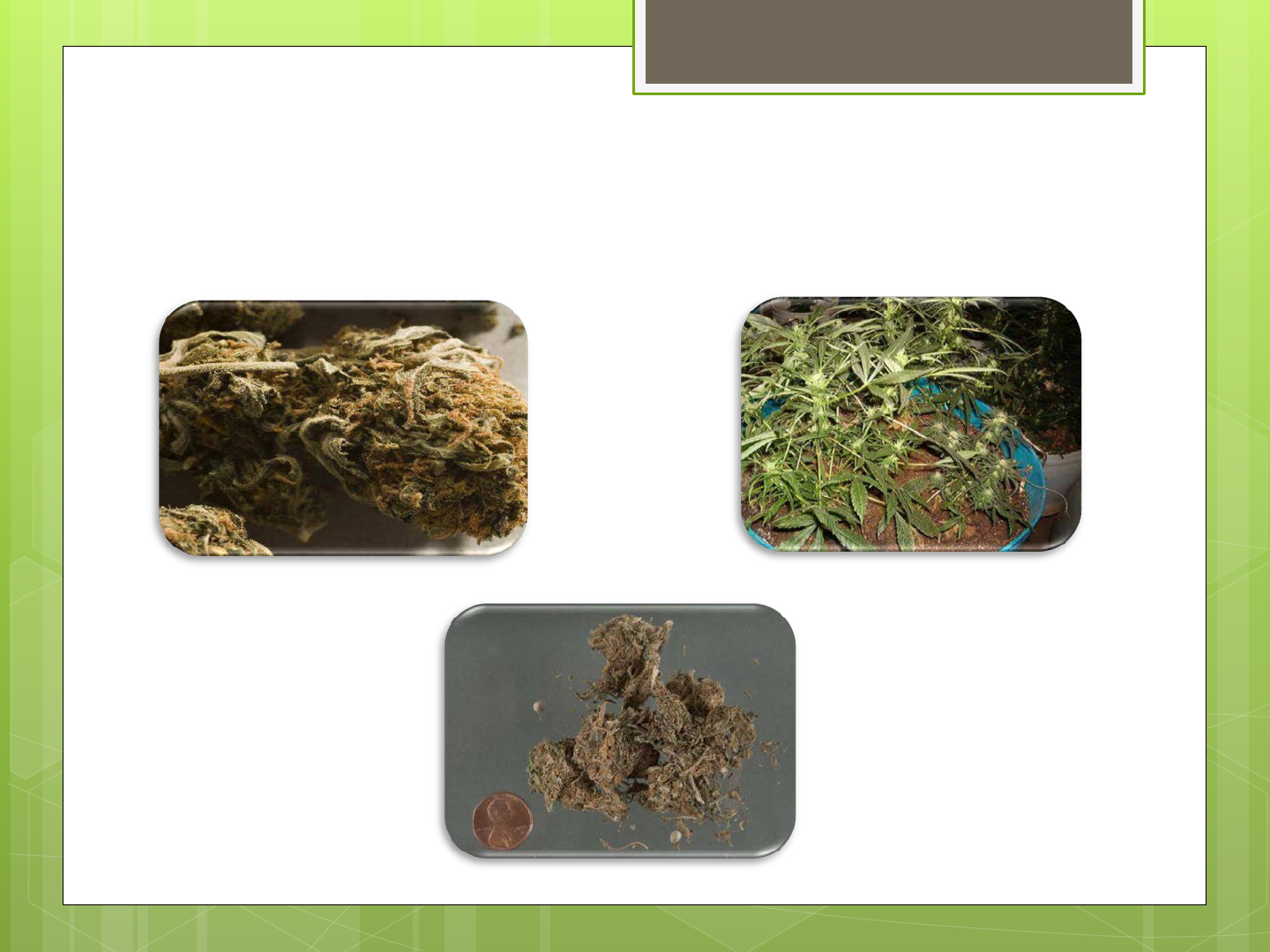
Marijuana Basics
Common Forms
5

Marijuana Basics
Common Forms
• Hashish’ (or ‘hash’) is the pure resin separated
and collected from the flowering tops of the
cannabis plant.
• Depending on purity it varies in color from
golden brown to black. It can be smoked,
eaten or vaporized.
• Hashish oil is produced by removing the
cannabinoids from the plant material with a
liquid.
• In the U.S., marijuana, hashish and hashish oil
are Schedule I controlled substances.
6
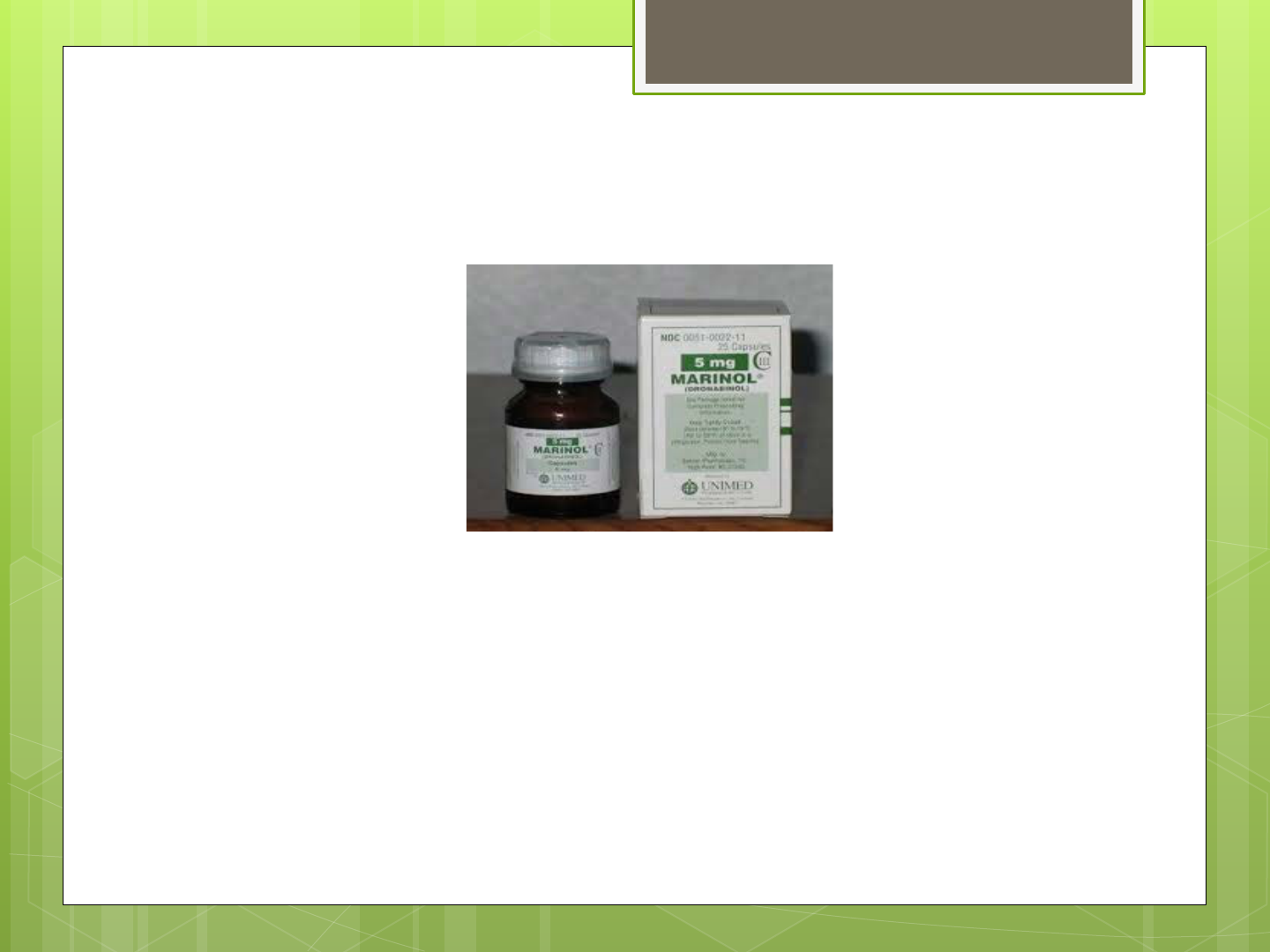
Marijuana Basics
Common Forms
7
Marinol® is a Schedule III controlled substance that
has the active chemical CBD* and comes in pill form.
Marinol is obtained through a prescription..
*Cannabidiol – The second main ingredient in cannabis used widely for medical
purposes
.

Marijuana Basics
• Marijuana is usually smoked as a cigarette (‘joint’), a
cigar (‘blunt’), or through a water pipe or bong.
• Marijuana can also be orally ingested. (Baked into food,
boiled in water to make tea, or pill form in the case of
Marinol.)
• Marijuana can be heated with a liquid until the active
ingredients turn to vapor which can be inhaled.
• Can be laced with or combined with other drugs such
as PCP.
8

Slang/Street Names
9
• Pot
• Ganja
• Herb
• Weed
• Mary Jane
• Grass
• Chronic
• Kif
• Reefer
• Skunk
• Boom
• Gangster
• And more than 200
others
• Different strains of
marijuana have their
own “brand” names

Marijuana Basics
Common effects include:
• Paranoia
• Short term memory loss
• Relaxation
• Heightened sensory perception (brighter colors)
• Laughter
• Altered perception of time
• Increased appetite
• Euphoria
10

Marijuana Basics
• Over 111 million Americans have
tried it at least once.
• An estimated 2.4 million Americans
used it for the first time in 2012.
11
2012 National Survey on Drug Use and Health, SAMHSA, 2013

Marijuana Basics
• The FDA does not get involved to ensure safety of
marijuana due to marijuana being federally illegal.
• Marijuana is not inspected or certified, making it impossible
to assess its safety for ingestion.
• Chemicals such as insecticides and pesticides may be
applied to marijuana plants to enhance the growing
process.
• Marijuana can sometimes be laced with other drugs
and/or substances(such as bath salts/cocaine)making the
use of marijuana much more dangerous.
12

Marijuana Basics
• K2 or spice = a synthetic cannabinoid.
• Does not come from the cannabis plant.
• Mixture of herbs and spices sprayed with
a synthetic compound chemically similar
to THC.
• Dangerous because toxicity of the
components can vary and be unknown.
• It is smoked or added to food and drinks.
13

New drug under FDA
Investigation
• Sativex – contains both THC and CBD (non-
psychoactive).
• FDA is investigating drug as an analgesic
treatment for patients with advanced cancer
whose pain cannot be controlled with FDA
approved opioids.
• Product not available for purchase in U.S. and
used only for FDA approved clinical trials.
14
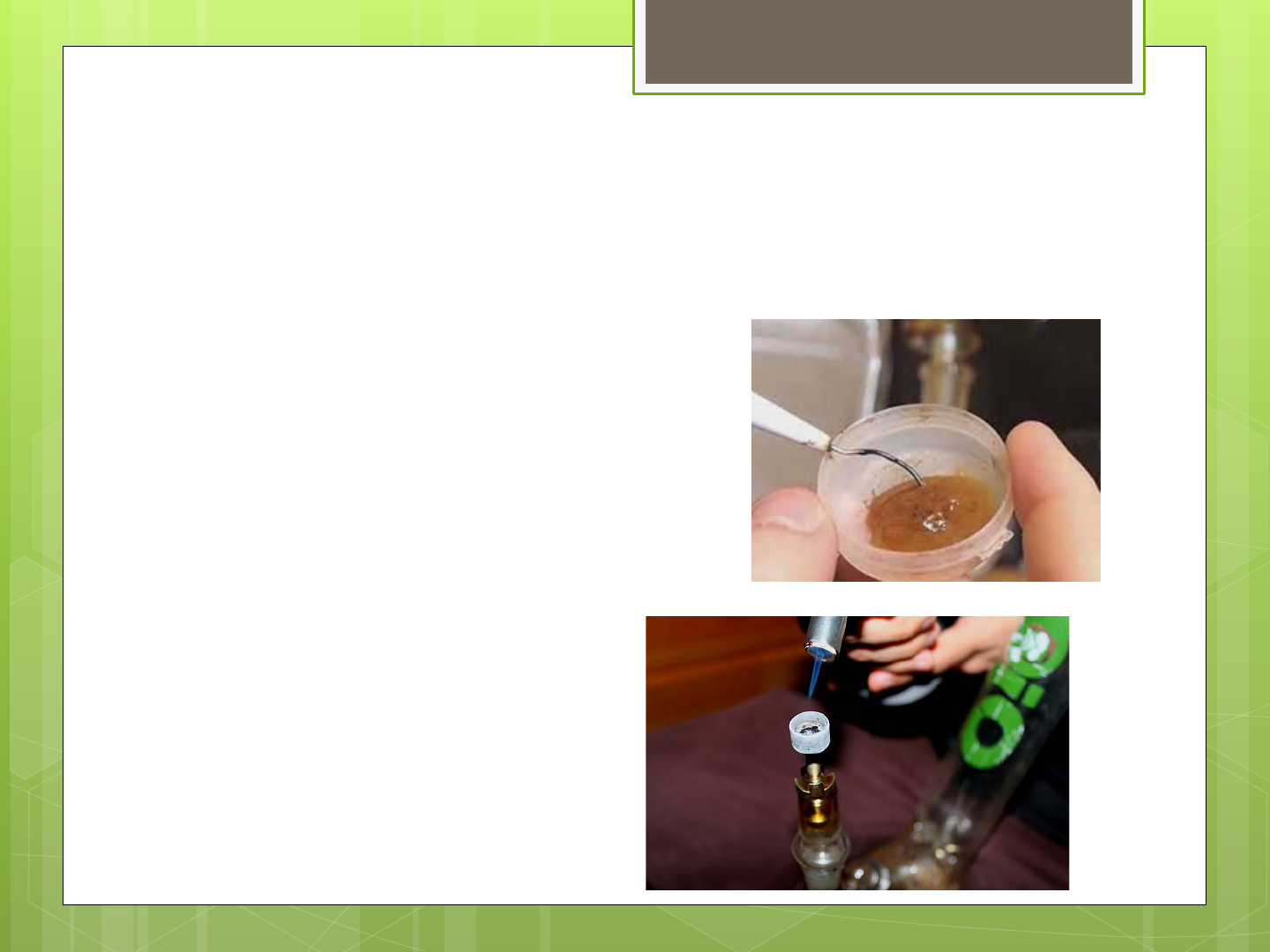
New Trends - Dabbing
• Hash oil
• Budder
• Honey Oil
• Wax or Ear Wax
• Smoked in oil rig
• 1 dab = 5 joints*
15

New Trends: Wax
• Made by removing the THC from the marijuana
by using butane which is highly flammable.
Similar methods are used in the production of
methamphetamine, cocaine and crack.
• Wax may contain 70% to 90% of THC. Users may
have a high that lasts up to 24 hours.
• Wax is legal in CO, for anyone over the age of
21 and can be bought in recreational
marijuana dispensaries.
16

New Trends -Vaporizers
• Teens have discovered the “G-Pen”
which is used for medical marijuana.
• Gives the appearance of a pen or
electronic cigarette.
• Does not produce smoke or any
odor.
17

Marijuana:
Impairment
18

Impairment
Effects of marijuana vary as a result of:
• Individual physical characteristics
metabolism/weight/age
• Dose (quantity and frequency)
• Route of administration
• Experience of user
• Other substance use
19
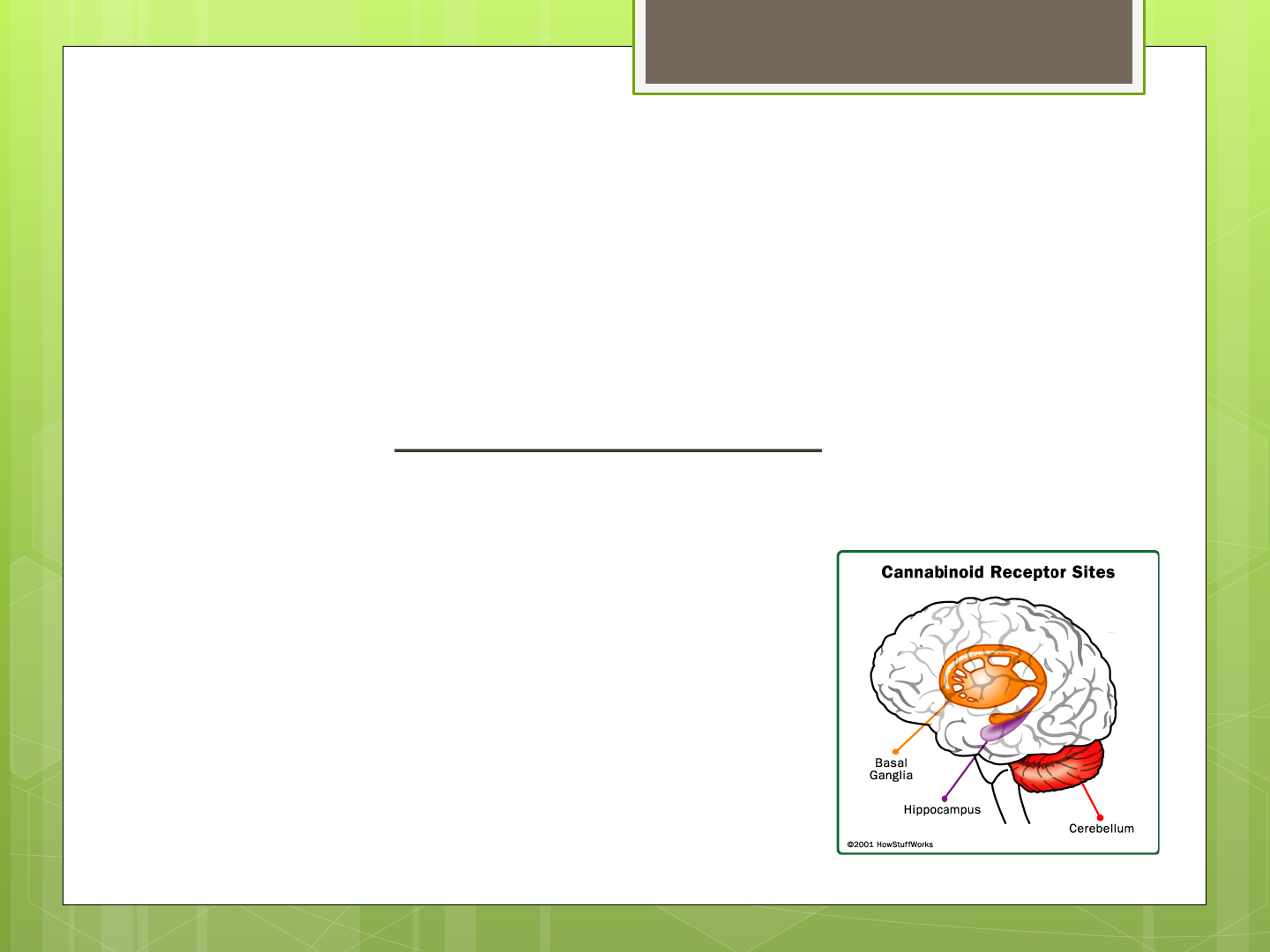
Marijuana, the Brain, and Impairment
• The human brain is not fully developed until age 25.
• The teen brain is more vulnerable to the negative effects of
marijuana use.
• THC affects the (cannabinoid receptors) parts of the brain that
influence pleasure, memory, thinking, sensory, time
perception, coordinated movement and concentration. A
“high” is produced when these parts of the brain are
overstimulated.
• The effects of being high creates:
• Memory problems
• Problems with processing information
• Poor sensory & time perception
• Poor concentration & coordination
Source: NIDA Research Report Series: Marijuana Abuse (rev. July 2012)
20

Impairment
Lasting impairment after use can result in difficulty
with:
• Complex tasks
• Learning new skills
• Alertness and attention
• Ability to recall information
• Decision making
When using, impaired decision-making can result in:
• Risky sexual behavior – STD’s, HIV and
unintended pregnancy
• Increased risk of exposure to other substances
Source: Jacobus, J, Bava, S. et. al. (2009) Functional Consequences of Marijuana Use in
Adolescence. Pharmacology, Biochemistry and Behavior 92(4).
21

Impairment: Coordination
THC disrupts coordination and balance by binding
to receptors in the part of the brain that regulates
balance, posture, coordination, and reaction time.
Therefore learning and doing complicated tasks,
like driving and participating in athletics, are
affected.
22

Impairment: Driving
• Teens are at a high risk of being involved in vehicle accidents.
When combined with their lack of experience, being under
the influence of marijuana increases this risk even further.
• Studies found that driving ability became impaired after
marijuana use.
• Drivers under the influence of marijuana have shorter
attention spans and reduced reaction times.
• Driving while or after smoking marijuana is illegal.
Source: Asbridge, M & Hayden, JA (2012) Acute cannabis consumption and motor vehicle collision risk:
systematic review of observational studies and meta-analysis. British Medical Journal , 344:e536
23

Impairment: Driving (1 of 2)
Since 2000, Liberty Mutual Insurance and
Students Against Destructive Decisions
(SADD) has been conducting a study of
teens driving under the influence. Data from
the most recent report, released in February
2012 shows:
Nearly 1 in 5 teens have gotten behind the
wheel after smoking marijuana.
24

Impairment: Driving (2 of 2)
Driving under the influence of marijuana (19%) is a
greater threat than driving under the influence of
alcohol (13%). Study findings show that teens don’t
consider marijuana use a distraction to their driving.
Study also found that most teen drivers would not drive
while under the influence if asked by their passengers
not to. However, teen passengers are less concerned
about riding in a car with a driver who has smoked
marijuana than one who has used alcohol.
Source: “Hazy Logic: Liberty Mutual Insurance/SADD Study Findings Driving Under the
Influence of Marijuana a Greater Threat to Teen Drivers than Alcohol.” Liberty Mutual
Press Release. February 22, 2012.
http://www.sadd.org/press/presspdfs/marijuana%20Teen%20Release.pdf
25
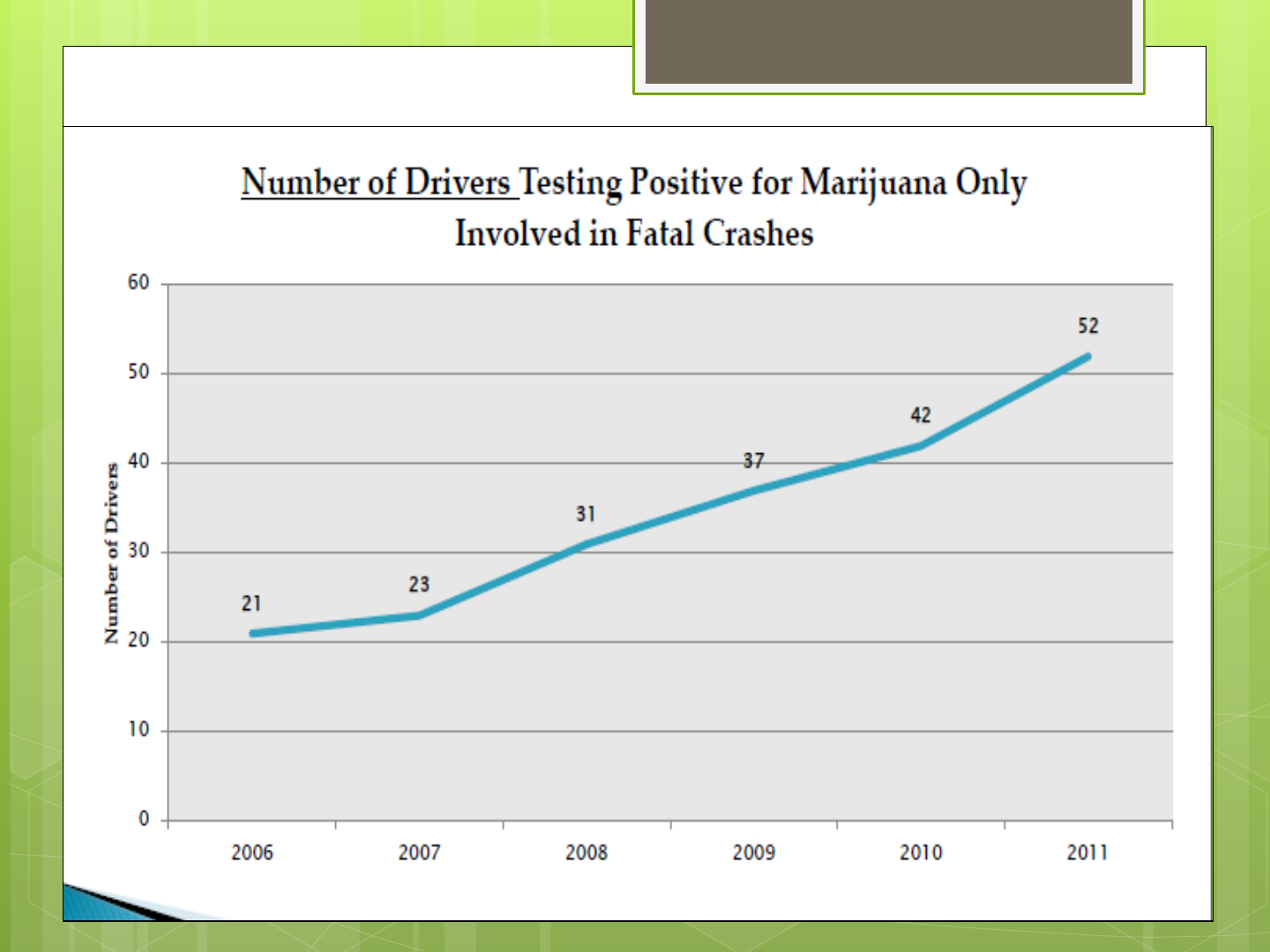
26

Impairment: Memory
• Marijuana use impairs a person's ability to form new
memories and to shift focus.
• Memory impairment from marijuana use occurs
because THC alters how information is processed.
• Adolescents who used marijuana regularly:
• Had compromised processing abilities when learning new
information
• Had difficulty with retaining new memory
• Made more errors on tests
• Had more difficulty paying attention
27
Source: Jacobus, J, Bava, S. et. al. (2009) Functional Consequences of Marijuana Use in Adolescence .
Pharmacology, Biochemistry and Behavior 92(4).

Health:
Marijuana’s
Effects on the
Brain and Body
28

Health: Effects on the Brain
Recreational doses* may cause:
*Recreational dose: used without medical justification
for its effects often in the belief that occasional use of
such a substance is not habit-forming or addictive. The
only medical justification of marijuana by the FDA is in
the form of Marinol.
(www.merriam-webster.com/dictionary/recreational%20drug)
29
Disorientation Altered time/space perception Panic reactions
Euphoria Poor Concentration Paranoia
Sedation Impaired learning/memory Drowsiness
Relaxed Inhibitions
Altered thought formation
More vivid senses

Health: Effects on the Brain
Frequent doses may cause:
Intensified reactions
Fluctuating emotions
Fragmentary thoughts with
disassociations
Dulling of attention
Image distortion
Acute psychosis* (including
hallucinations, delusions, and a
lost sense of personal identity)
30
*Short-term psychotic reactions to high concentrations of THC are
distinct from longer-lasting, schizophrenia-like disorders that have
been associated with the use of cannabis in vulnerable individuals.
Symptoms occur more frequently when a high dose of
cannabis is consumed in food or drink rather than smoked.
"Marijuana Abuse." National Institute on Drug Abuse. National Institute on Health, July 2012. Web. 13 Sept. 2013.
<http://www.drugabuse.gov/publications/term/162/Research%20Reports>.
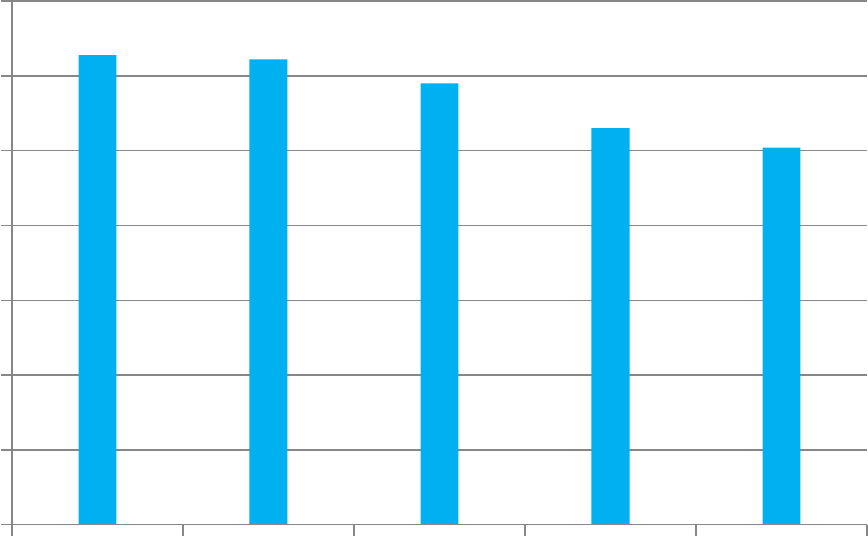
31.4
31.1
29.5
26.5
25.2
0
5
10
15
20
25
30
35
Never used
cannabis
Hash at
week ends
or less
Hash
everyday
Skunk at
week ends
or less
Skunk
everday
Mean (age) Years of Onset of Psychosis by
Degree of Exposure to Cannabis
Source: M. Di Forti et al. (2013). Daily Use, Especially of High-Potency
Cannabis, Drives the Earlier Onset of Psychosis in Cannabis Users.
Schizophrenia Bulletin.
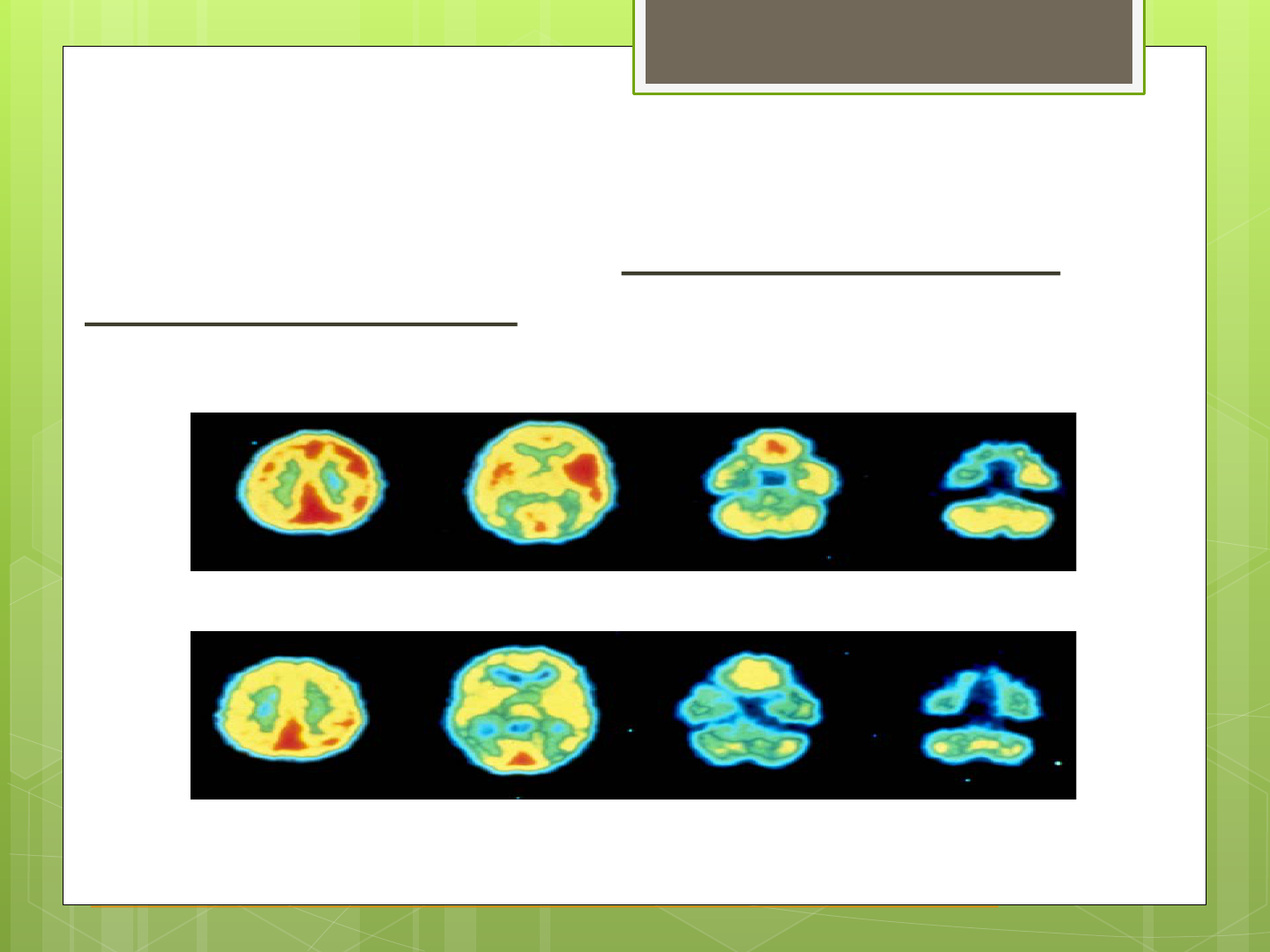
Health: Effects on the Brain
Over time, regular exposure to THC can permanently
alter how the brain works, even if the drug is not
currently being used.
32
Control
Marijuana Abuser
Source: Volkow et al., Psychiatry Research: Neuroimaging, 67, pp. 29-38 (1996). This slide is from: Volkow,
ND (2011) Marijuana’s Effects on Brain, Body and Behavior. Presentation March 8, 2011.
http://www.apa.org/about/gr/science/spin/2011/03/volkow-marijuana-presentation.pdf

Health: Effects on the Body
Marijuana use can cause teens to overestimate their
abilities & impair good judgment resulting in risky
behaviors such as:
• Unplanned and/or unprotected sex
• Dangerous stunts/actions
• Operating a car, ATV, snowmobile, boat, bike
while under the influence
33
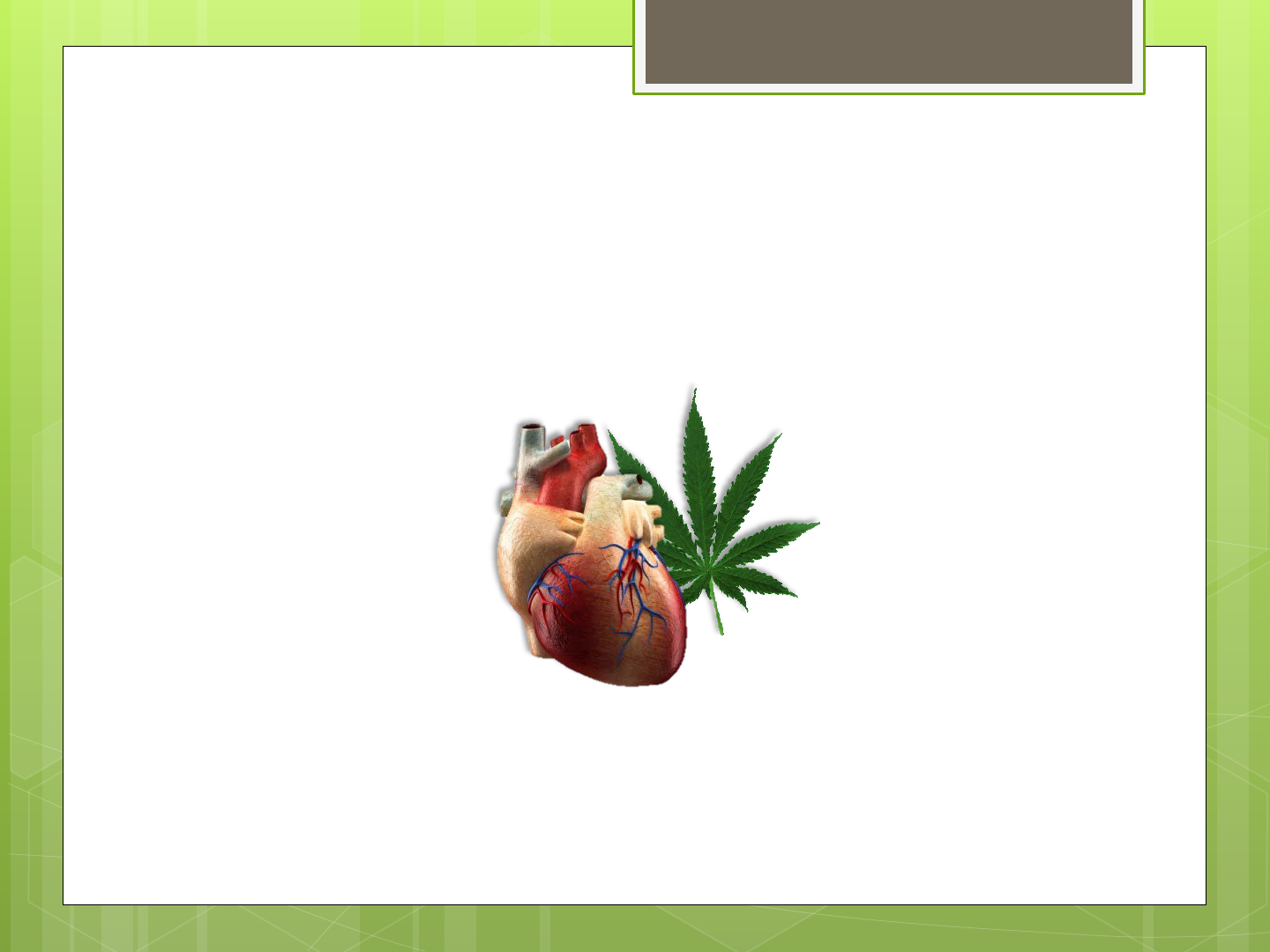
Health: Effects on the Body
Marijuana can cause the heart rate to
increase by 20 to 50 beats per minute. This
increase can last for hours after use has
stopped.
Increased heart rates can be even greater if
other drugs are used at the same time
.
Source: Mittleman MA, Lewis RA, Maclure M et al. (2001) Triggering myocardial infarction by marijuana.
Circulation, 103(23) 2805–2809.
34

Health: Effects on the Body
Researchers found that marijuana users
with pre-existing conditions have an
increased risk for a heart attack
compared to the general risk of heart
attack when not smoking.
Source: Mittleman MA, Lewis RA, Maclure M et al. (2001) Triggering myocardial infarction by
marijuana. Circulation, 103(23) 2805–2809.
35

Health: Effects on the Body
The amount of tar inhaled by marijuana smokers
and the level of carbon monoxide absorbed are
three to five times greater than from tobacco
smoke.
Drugs and Human Performance Fact Sheets - Cannabis / Marijuana. National Highway Traffic Safety
Administration, n.d. Accessed at: http://www.nhtsa.gov/people/injury/research/job185drugs/cannabis.htm
.
Marijuana contains more cancer causing chemicals
than tobacco. Marijuana smokers inhale deeply
and hold the smoke in their lungs longer which may
increase their risk for developing lung cancer.
The British Lung Foundation (2012) The Impact of Cannabis on Your Lungs. Accessed at:
http://www.blf.org.uk/Files/8ec171b2-9b7e-49d9-b3b1-a07e00f11c05/The-impact-of-
cannabis-on-your-lungs---BLF-report-2012.pdf
36

Health: Effects on the Body
• The California’s Office of Environmental
Health Hazard Assessment placed
marijuana smoke on its official list of
known carcinogens in 2009.
Tomar, R. S., Beaumont, J., & Hsieh, J. C. Y. (2009). Evidence on the Carcinogenicity of
Marijuana Smoke. California Environmental Protection Agency. Reproductive
and Cancer Hazard Assessment Branch, Office of Environmental Health Hazard
Assessment.
37

Health: Effects on the Body
Recent studies have
shown a link between
frequent marijuana use
and the occurrence of
testicular cancer.
Lacson, J., Carroll, J., Tuazon, E., Castelao, E., Bernstein, L., & Cortessis, V. (2012). Population –
based case-control study of recreational drug use and testis cancer risk confirms an
association between marijuana use and nonseminoma risk. Cancer, 118(21) 5374-5383.
38

issues
?
Did you know marijuana use can
interfere with the safety and/or
effectiveness of medicines people
take to treat health problems??
Marijuana use can interfere with medicine
prescribed by a doctor.
Resources:
www.rxlist.com/marijuana-page3/supplements.htm
or
http://www.webmd.com/drugs/index-drugs.aspx
39

Impact on the Family
• For parents who use marijuana, their ability to
parent may be impacted by “difficulty picking
up on their babies’ cues because marijuana
dulls response time and alters perceptions.”
• “When parents repeatedly miss their babies’
cues, the babies eventually stop providing
them which results in disengaged parents with
disengaged babies.”
Source: Protecting Children in Families Affected by Substance Use Disorders: Child Abuse
and Neglect User Manuel Series,” U.S. Department of Health and Human Services
Administration for Children and Families, Administration on Children, Youth and Families
Children’s Bureau, Office on Child Abuse and Neglect, 2009.
40

Impact on the Family
Some parents may choose to grow marijuana in their
home or live in a marijuana growing operation which has
negative impacts on children’s health:
• Mold exposure
• Possible electric shock
• Exposure to high levels of carbon monoxide
• Explosion risks
• Bobby traps and weapons
• Potential eye damage from ultraviolet lights
• Exposure to dangerous chemicals used in the growing
process
Source: “Capital Health, Edmonton Area: Public Health Division, Environmental Public Health Services
Fact Sheet.”
41

Unintentional Pediatric
Marijuana Exposures
• 985 calls to US poison centers in children ages
9 and younger between 2005 and 2011.
• Rate of calls in states that passed legislation
legalizing marijuana use (recreational or
medicinal purposes) before 2005 increased
from 3.9 calls per 100,000 population in 2005 to
14.8 calls per 100,000 population in 2011.
42
Source: CESAR Fax March 3, 2014.
Vol. 23, Issue 8

Unintentional Pediatric
Marijuana Exposures
• Rate of calls in transitional states (enacted
legislation to legalize marijuana) between 2005
and 2011 increased from 5.2 calls per 100,000
population to 8.7 calls per 100,000 population.
• Rate of calls in states that did not pass
legislation saw no change in the rate of poison
center calls.
43
Source: CESAR Fax March 3, 2014.
Vol. 23, Issue 8

Unintentional Pediatric
Marijuana Exposures
• “Increased call rate may be caused by increase
in:
• use by family members
• likelihood of ingestion
• potency of ingestion
• likelihood of caregivers calling poison centers or
presenting to health care facilities for help.”
• Need for “child-resistant packaging, warning
labels and public education, when drafting
marijuana legislation.”
44
Source: CESAR Fax. March 3, 2014, Vol. 23, Issue 8.
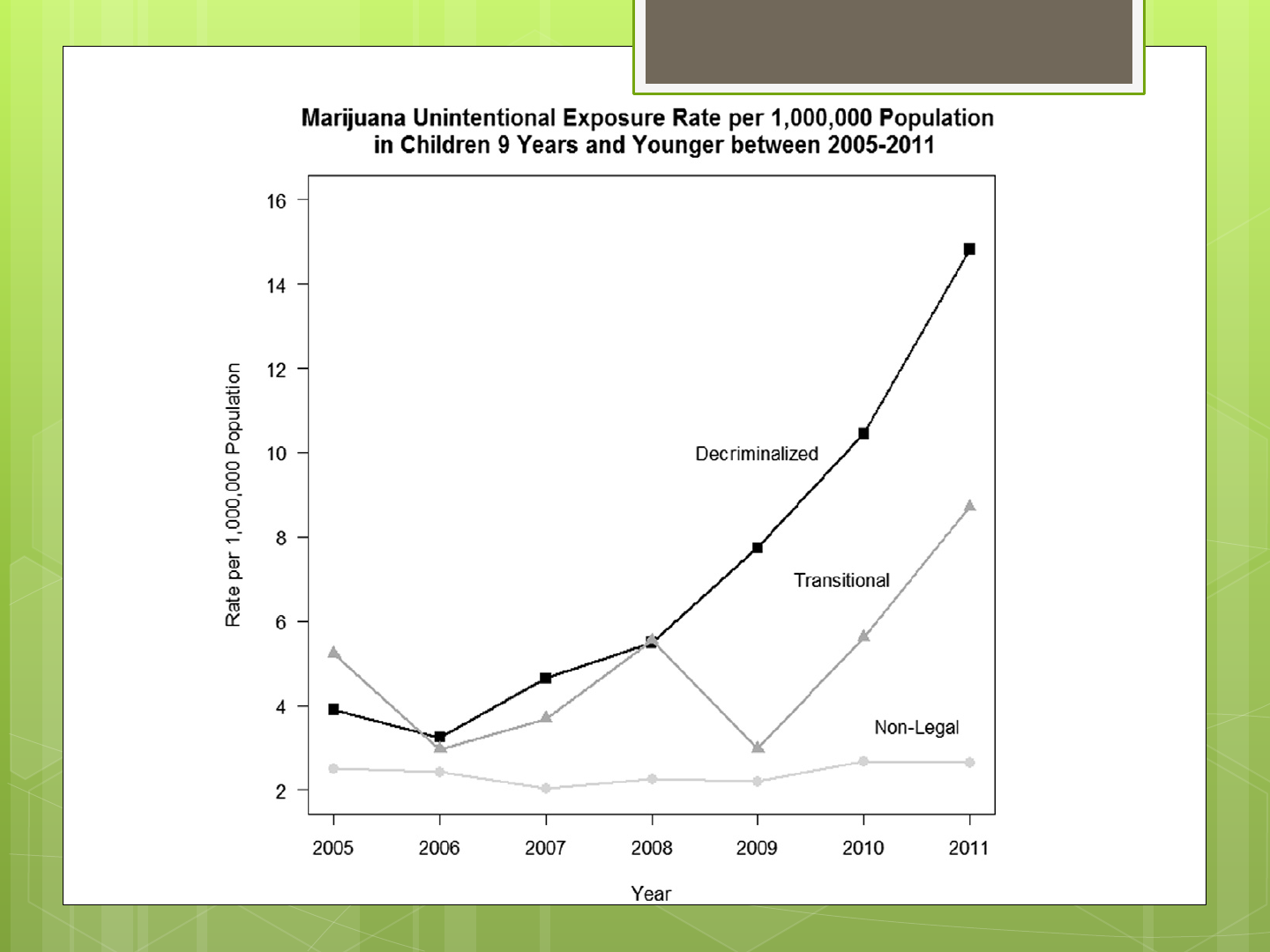
45

Future
Success:
Getting High
Can Really
Bring You Down
46

Future Success
• Teen marijuana use has negative
consequences in the areas of education,
skill training and job opportunities.
• Marijuana use among teens has been linked
to lower school performance and reduced
job prospects.
Source: Jacobus, J, Bava, S. et. al. (2009) Functional Consequences of Marijuana Use in Adolescence .
Pharmacology, Biochemistry and Behavior 92(4).
47

Future Success:
Impact on Education
Research shows that teen marijuana use affects their
education by:
• Lowering academic performance
• Increasing truancy & drop out
• Reducing likelihood of graduation
• Interfering with future goal setting or life planning
• Higher risk of future unemployment
Source: Jacobus, J, Bava, S. et. al. (2009) Functional Consequences of Marijuana Use in
Adolescence . Pharmacology, Biochemistry and Behavior 92(4).
48
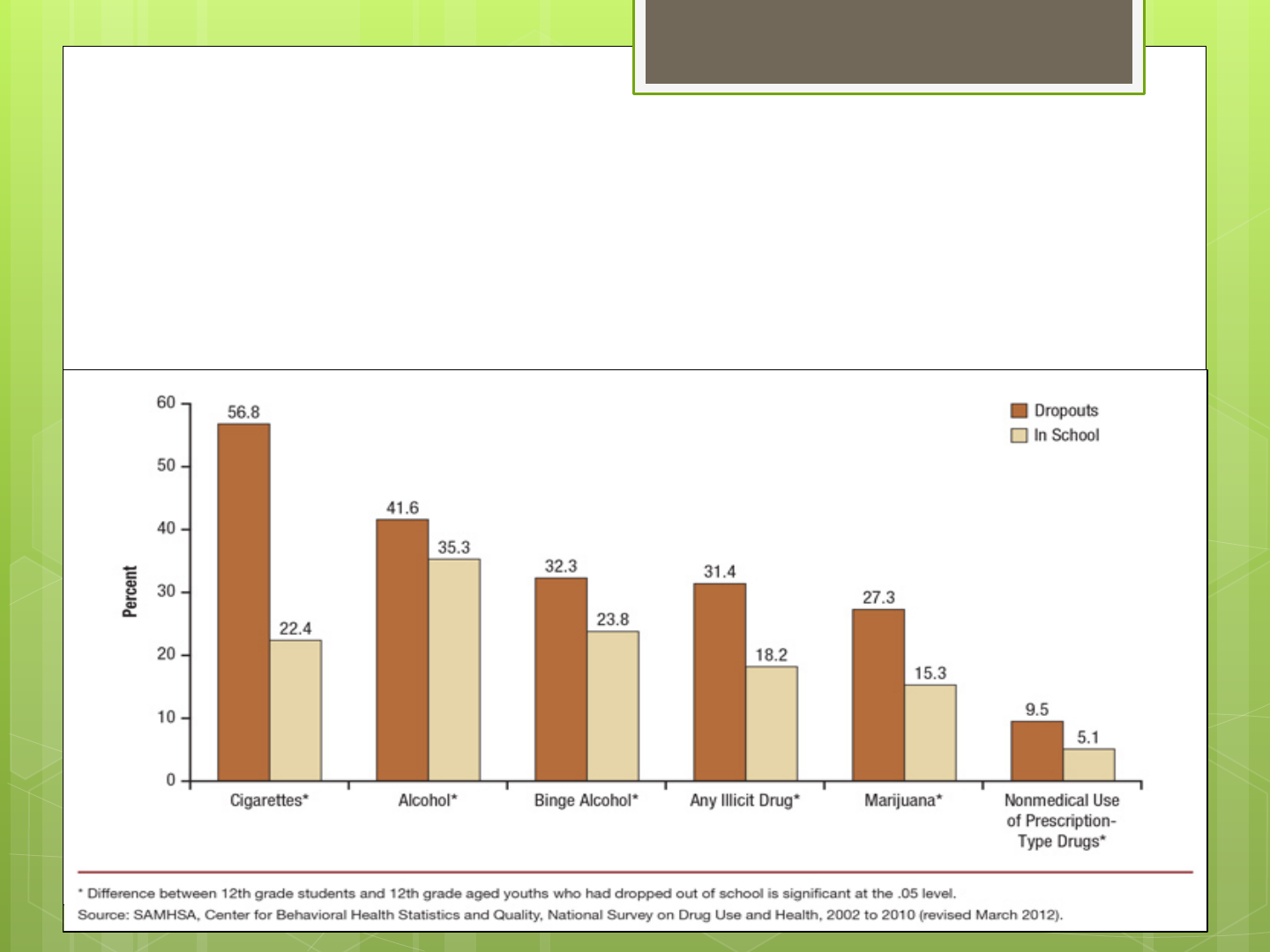
Marijuana Use and School Drop Out
Dropping out of high school is related to a number of negative
socioeconomic and health outcomes.
One in seven 12th graders dropped out of high school and had
higher rates of current substance use than similar aged peers who
were still in school.
49

Future Success: Impact on Education
50
Students who are cited for illegal drug
use/possession while receiving student
financial aid may be at risk for losing their
financial aid and/or federal student loans.
Source: U.S. Dept. of Education "Students with Criminal Convictions Have Limited Eligibility for Federal
Student Aid." Accessed Aug. 12, 2013 at: http://studentaid.ed.gov/eligibility/criminal-
convictions#drug-convictions

Future Success: Impact on Education
Those with a drug possession conviction may be
asked to complete substance abuse treatment prior
to acceptance to college or technical schools.
Source: U.S. Dept. of Education "Students with Criminal Convictions Have Limited Eligibility for Federal Student
Aid." Accessed Aug. 12, 2013 at: http://studentaid.ed.gov/eligibility/criminal-convictions#drug-convictions
51

Future Success: Impact on Education
In a study of college students, heavy marijuana
users:
• Made more errors
• Had more problems paying attention to
changes in the environment
• Had more problems learning than students
who used less often or not at all
Source: Harvey M.A, Sellman J.D., Porter R.J., Frampton C.M., (2007) The relationship between non
acute adolescent cannabis use and cognition. Drug and Alcohol Rev. 2007 Vol.6 309-19
52

Marijuana and IQ
53
• Researchers in New Zealand conducted a
prospective study with 1,037 individuals from
birth till age 38.
• IQ tests were administered at ages 13 and 38.
• Marijuana use was gathered in interviews at
ages 18, 21, 26, 32 and 38.
• IQ scores were compared as a function of
marijuana use.
Meier et al. (2012). Persistent Cannabis Users Show Neuropsychological Decline from
Childhood to Midlife. Proceedings of the National Academy of Science, vol. 109, no 40 (E2657 – E2664).

Marijuana and IQ
• Study findings showed individuals who used
marijuana heavily in their teens and continued
through adulthood had a drop in IQ between
ages 13 to 38.
• Average of 8 points for those who met a diagnosis
of marijuana dependence.
• “Loss of 8 IQ points could drop a person of
average intelligence into the lowest third of the
intelligence range.”
54
Meier et al. (2012). Persistent Cannabis Users Show Neuropsychological Decline from
Childhood to Midlife. Proceedings of the National Academy of Science, vol. 109, no 40 (E2657 – E2664).

Future Success: Impact on Employment
Several studies have linked workers’ marijuana smoking
with:
• Increased absences
• Tardiness
• Accidents
• Workers’ compensation claims
• Job turnover
Individuals who tested positive for marijuana on
pre-employment urine screens had:
• 55% more industrial accidents
• 85% more injuries
• 75% increase in absenteeism compared with those who
tested negative for marijuana use.
Source: NIDA Research Report Series: Marijuana Abuse (rev. July 2012)
55

Future Success: Impact on Intimate
Partner Violence
• Studies show that regular use of marijuana
by teens and young adults increases their
risks of becoming victims or offenders of
intimate partner violence.
Source: Reingle, J. et al. (2012) The Relationship Between Marijuana Use and
Intimate Partner Violence in a Nationally Representative Longitudinal Sample.
Journal of Interpersonal Violence, 27(8): 1562-1578.
56
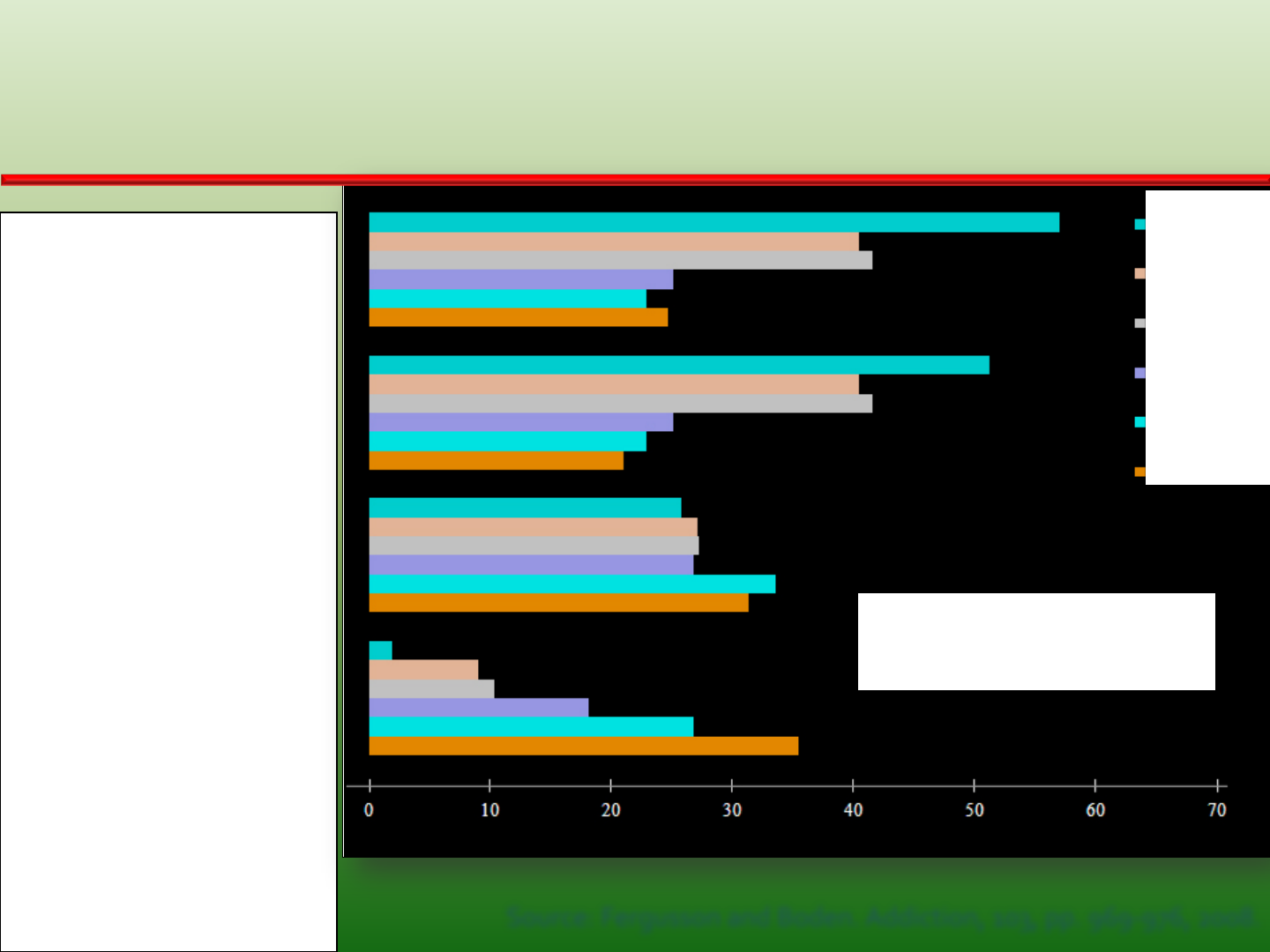
Source: Fergusson and Boden. Addiction, 103, pp. 969-976, 2008.
Number of occasions using
Cannabis between ages 14-21
% welfare dependent
(ages 21-25)
% Unemployed
(ages 21-25)
mean personal
income
in thousands of $
at age 25
% gained university
degree
by age 25
400+
300 to 399
200 to 299
100 to 199
1 to 99
Never
# of occasions using
Cannabis ages 14-21
Cannabis Use and Later Life Outcomes
Are Dose Dependent

Drug Testing and Synthetic
Cannabinoids
• Known as K2 or Spice.
• Usually not included in routine drug tests due
to the need for specialized expensive testing.
• Great variation between products so difficulty
with identifying what metabolites should be
included in testing.
58
Source: CESAR Fax. July 8, 2013 Vol. 22, Issue 27.

Drug Testing and Synthetic
Cannabinoids
• “Some synthetic cannabinoid users use the
drug as a substitute for marijuana to avoid
positive drug tests.”
• Most of the users returned to marijuana once
the drug-testing period ended.
• Per a study participant “spice would give you a
weed like effect without the positive test.”
59
Source: CESAR Fax. July 8, 2013 Vol. 22,
Issue 27.

Marijuana
and
Addiction
60

Marijuana and Addiction
Addiction:
• A state in which a person engages in a compulsive
behavior that may be reinforcing and initially
pleasurable.
• Loss of control when trying to limit intake.
• Continued use despite negative consequences.
Dependence:
• A person physically and mentally needs a drug in order
for their body to function normally.
• The body becomes dependent on a drug physically
and psychologically.
• Stopping the use of the drug leads to physical
withdrawal symptoms.
61

Marijuana and Addiction
Signs of Addiction:
• Experiencing difficulty controlling the urge to use
• Using before school/work/other activities
• Seeking out others who use
• Spending time thinking about using/talking about
using/seeking out the drug
• Continued use despite the negative consequences
It is suspected that the early use of marijuana by youth
coupled with a higher potency of the drug contributes to
greater rates of addiction.
Source: United Nations Office on Drugs and Crime (2012) Cannabis A Short Review: Discussion Paper
62

Marijuana and Addiction
Those who are addicted experience withdrawal
symptoms:
• Irritability
• Anxiety
• Insomnia or sleep disturbances
• Appetite Disturbance
• Depression
Most studies suggest that withdrawal symptoms start on the first day
of abstinence, and usually peak within the first 2 to 3 days of quitting,
with the exception of sleep disturbance.
Withdrawal symptoms are usually over after 2 weeks, but this
depends on how dependent someone is on cannabis before trying
to quit.
Source: National Cannabis Prevention & Information Centre. (2011) Cannabis Withdrawal: Factsheet 24. Accessed at:
http://ncpic.org.au/workforce/alcohol-and-other-drug-workers/cannabis-information/factsheets/pdf/cannabis-
withdrawal
63

Marijuana and Addiction
Marijuana dependence is the 3
rd
most common
type of drug dependence in many parts of the
world, including the U.S. and Canada. (Tobacco
and alcohol are 1
st
and 2
nd
)
Source: United Nations Office on Drug and Crime. ND. Cannabis A Short Review
1 in 6 who start using marijuana in their teens
become addicted.
Source: National Institute of Drug Abuse. Dec. 12,2012.
http://www.nih.gov/news/health/dec2012/nida-19.htm
Marijuana is the primary drug of abuse in 18 % of
U.S. treatment admissions.
Source: Substance Abuse and Mental Health Services Administration, Center for Behavioral Health
Statistics and Quality. Treatment Episode Data Set (TEDS): 2000-2010. National Admissions to
Substance Abuse Treatment Services.
64

Marijuana:
Perception of Harm
65

Marijuana: Then and Now
Marijuana has become more potent over the years.
The increase in marijuana potency means a smaller
amount can induce a greater level of intoxication, making
it easier to get higher, faster.
With legalization of medical marijuana, emphasis is on
growing plants with higher THC content and the quickest
way possible.
This leads to a type of “Hybrid” plant which is more likely to
be abused.
Source: Mehmedic Z, Chandra S, Slade D. et. al. (2010) Potency Trends of THC and Other
Cannabinoids in Confiscated Cannabis Preparations from 1993-2008. Journal of Forensic
Sciences, 55(5) 1209-17.
66
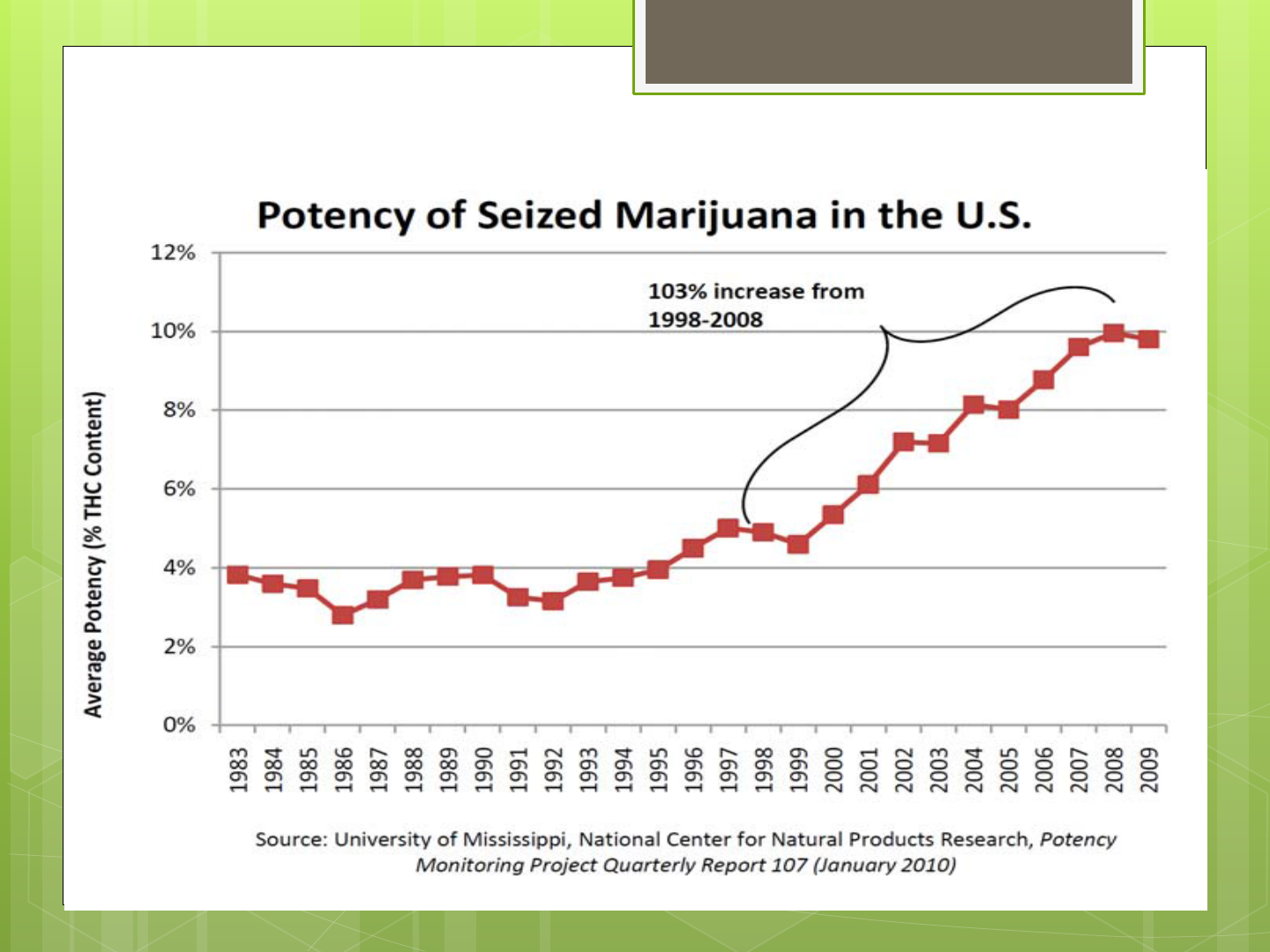
Marijuana: Then and Now
67

Perception of Harm
• People often pose the rhetorical
question: “Has anyone ever died
from using marijuana?”
• The answer is YES, when it is caused
by:
Motor vehicle collisions
Fatal accidents caused by
impaired judgment
Marijuana laced with another
drug
68

Marijuana and the Environment
• Illegal marijuana growers use chemicals, high
amounts of energy and make changes to land
structure leaving lasting damage to our
surroundings.
• They also use poisons to keep animals from
destroying their crops and equipment.
Source: Gabriel MW, Woods LW, Poppenga R, Sweitzer RA, Thompson C, et al. (2012)
Anticoagulant Rodenticides on our Public and Community Lands: Spatial Distribution of
Exposure and Poisoning of a Rare Forest Carnivore. PLoS ONE 7(7): e40163
69

Marijuana and the Environment
• The poison not only affects small animals
that eat it but also larger animals that prey
on them.
• Wildlife studies show that endangered
animals are also being exposed and killed
by these poisons.
Source: Gabriel MW, Woods LW, Poppenga R, Sweitzer RA, Thompson C, et al. (2012) Anticoagulant
Rodenticides on our Public and Community Lands: Spatial Distribution of Exposure and Poisoning of a Rare
Forest Carnivore. PLoS ONE 7(7): e40163
70

Marijuana and the Environment
• August 2009 – LaBrea Wildfire: began in
the Los Padres National Forest within the
San Rafael Wilderness area in Santa
Barbara County, CA and included
surrounding county and private lands.
• Destroyed 89,000 acres of land.
71

Marijuana and the Environment
• Per the US Forest Service, this fire was caused
by an illegal cooking fire at the site of a
recurring outdoor marijuana grow site.
• The grow site contained 20,000 marijuana
plants.
• Per the US Forest Service the fire cost $35
million (putting it out and resource damage).
72

Restoring Mother Nature
• Per the US Park Service it costs $14,900 to $17,700
per acre to clean-up and restore land
damaged by illegal marijuana growing.
• Costs include removing and disposing
hazardous waste, removing camp facilities,
irrigation hoses and garbage, etc.
Source: Marijuana Site Reclamation and Restoration Cost Analysis.” U.S. Department of Interior,
National Park Service. December 9, 2010(unpublished data).
73

Youth
Marijuana Use
in the United
States:
A Look at the
Data
74
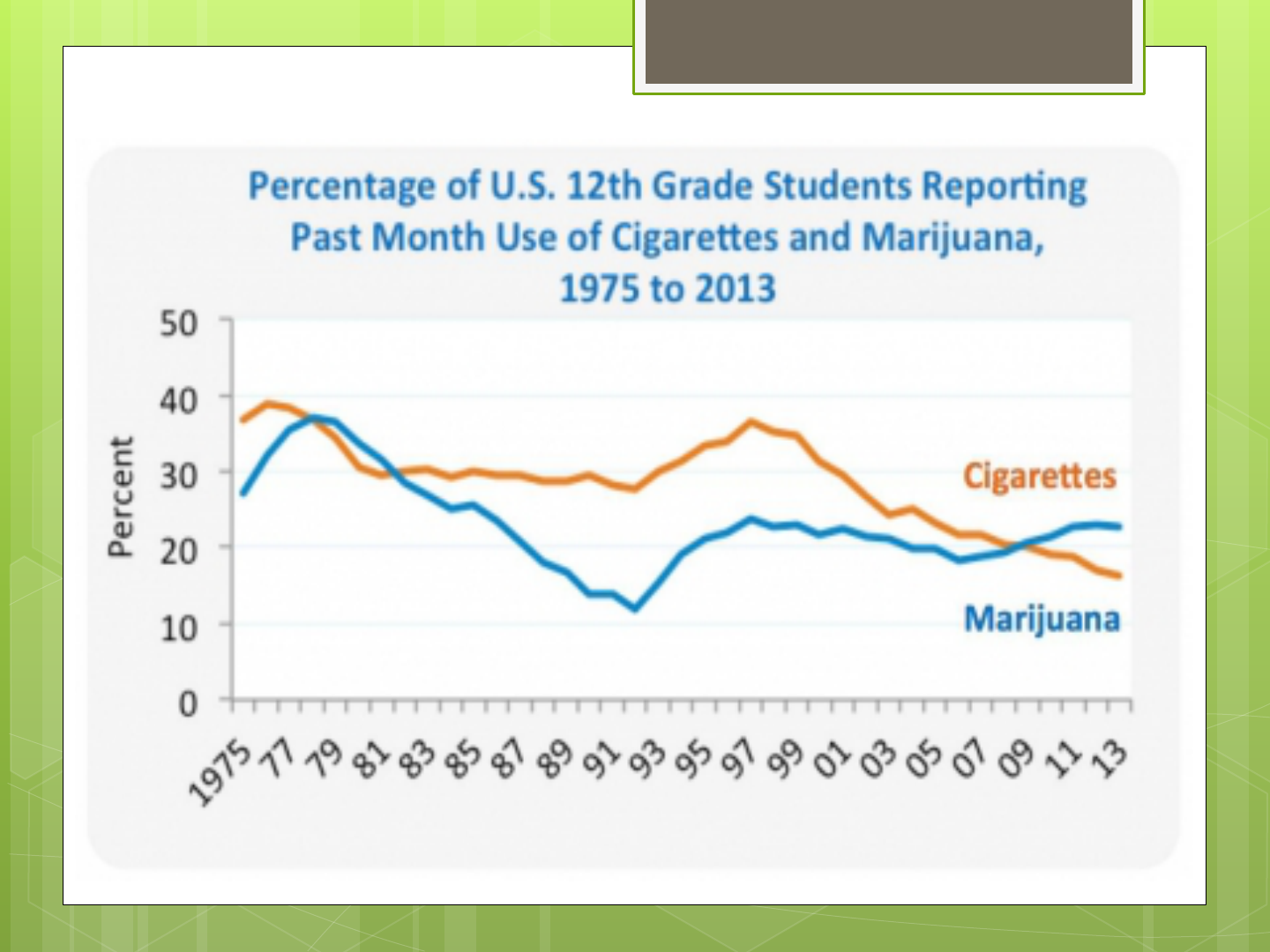
75
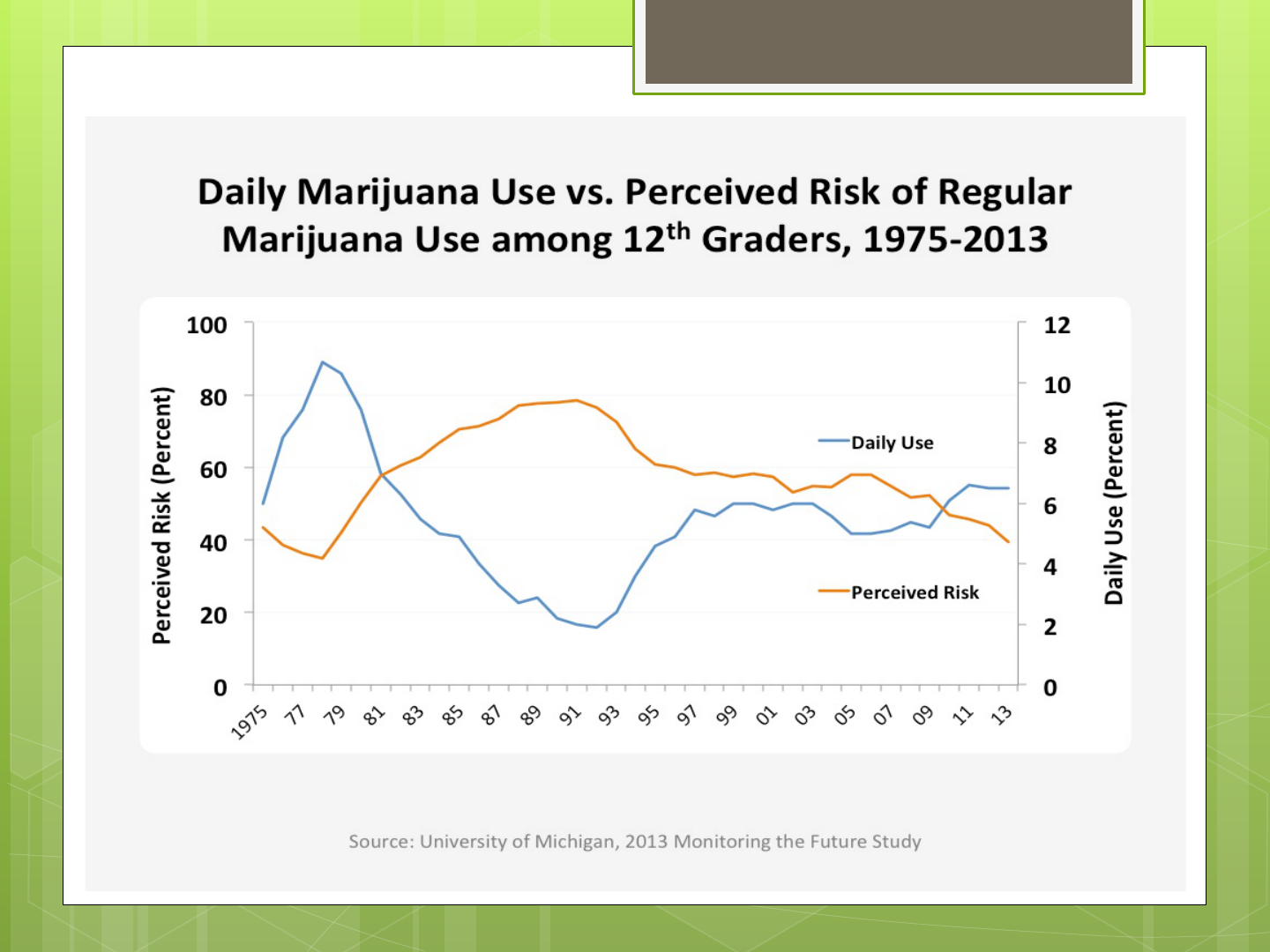
76
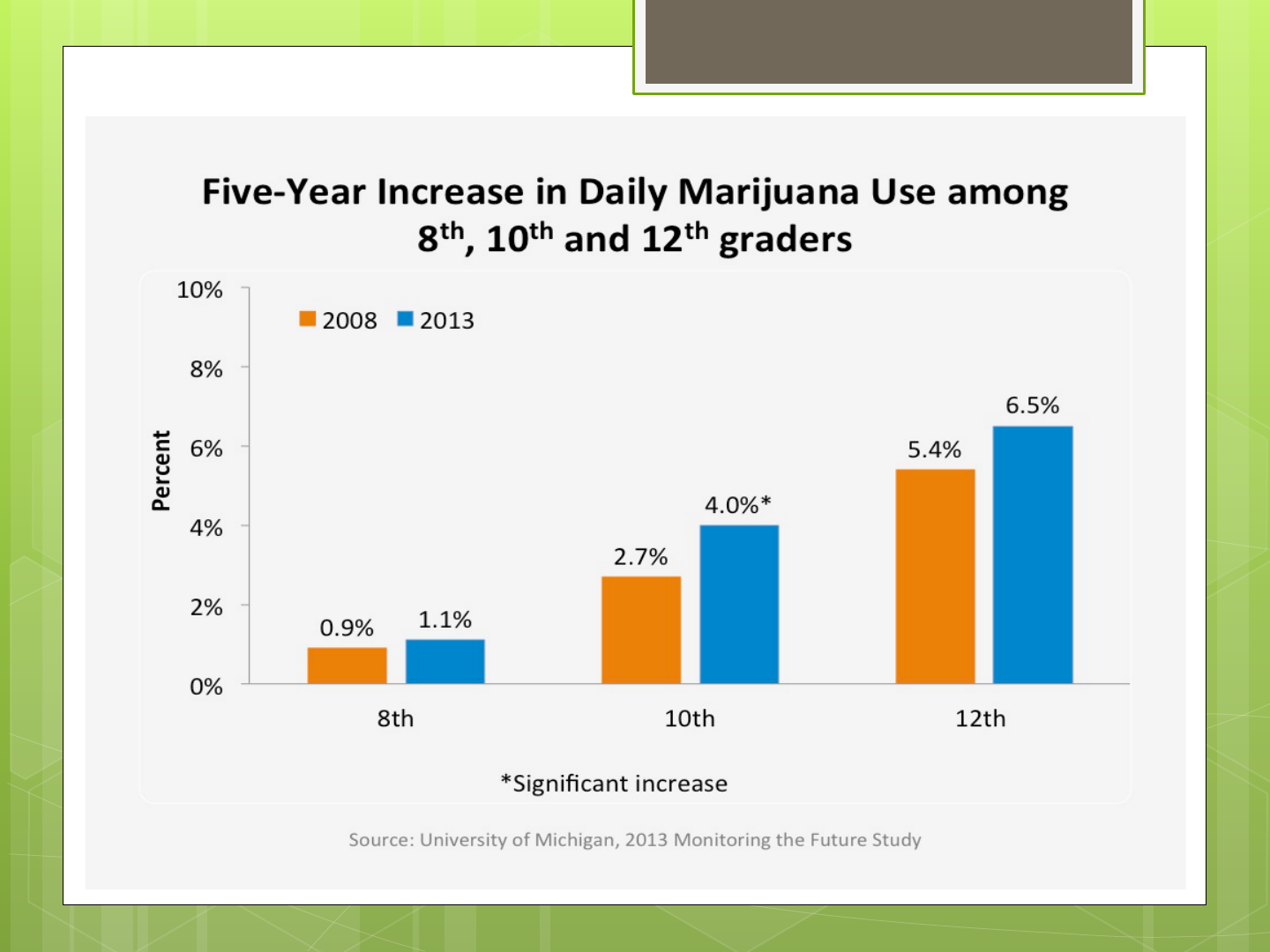
77
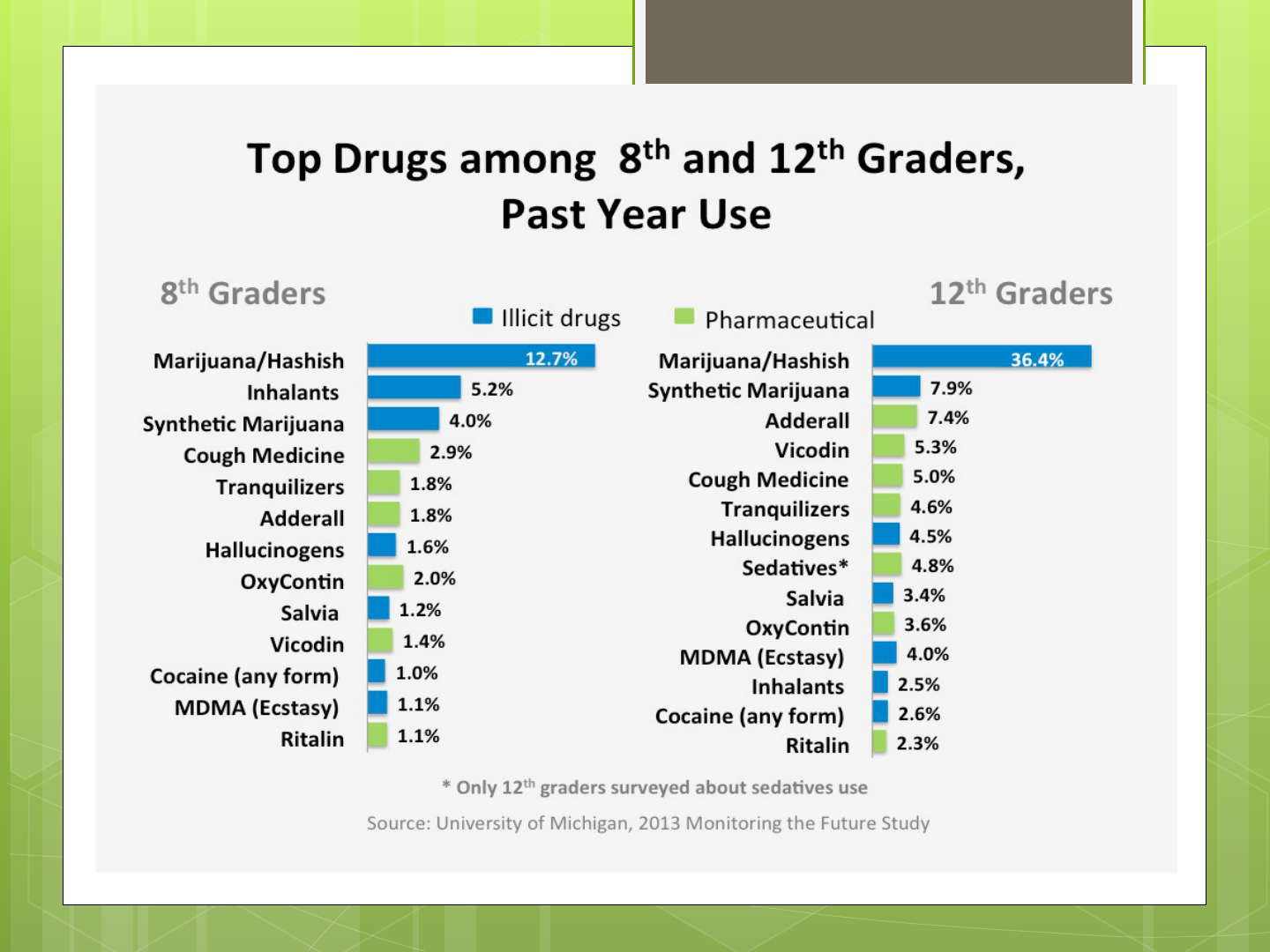
78

Marijuana
Use in
Maine:
A Look at the
Data
79
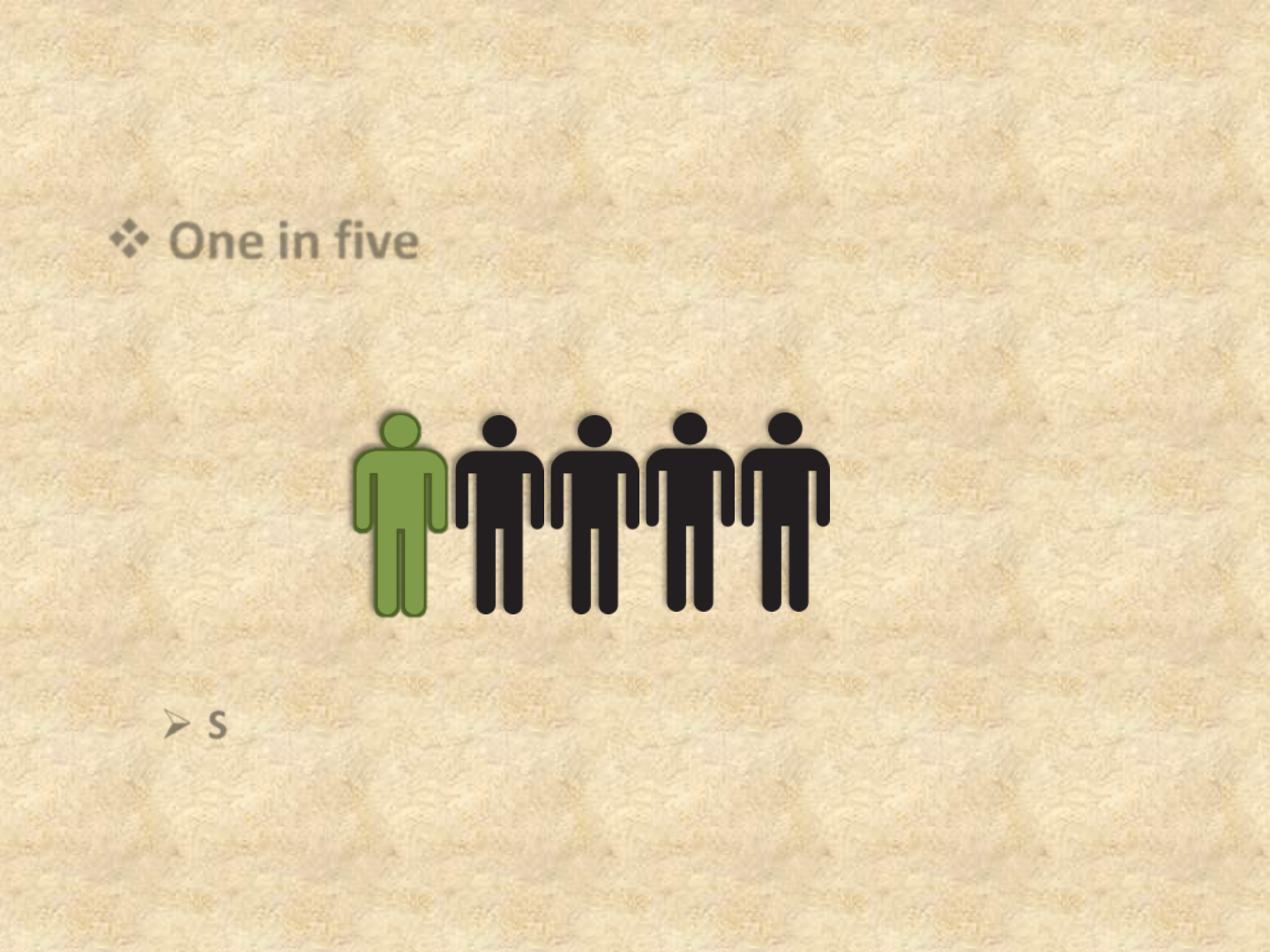
Youth and Young Adults
Similar rates are seen within the young adult (18-
25) population (Behavioral Risk Factors Surveillance System,
2012).
One in five high school students reported
using marijuana within the past month (Maine
Integrated Youth Health Survey , 2013).
80
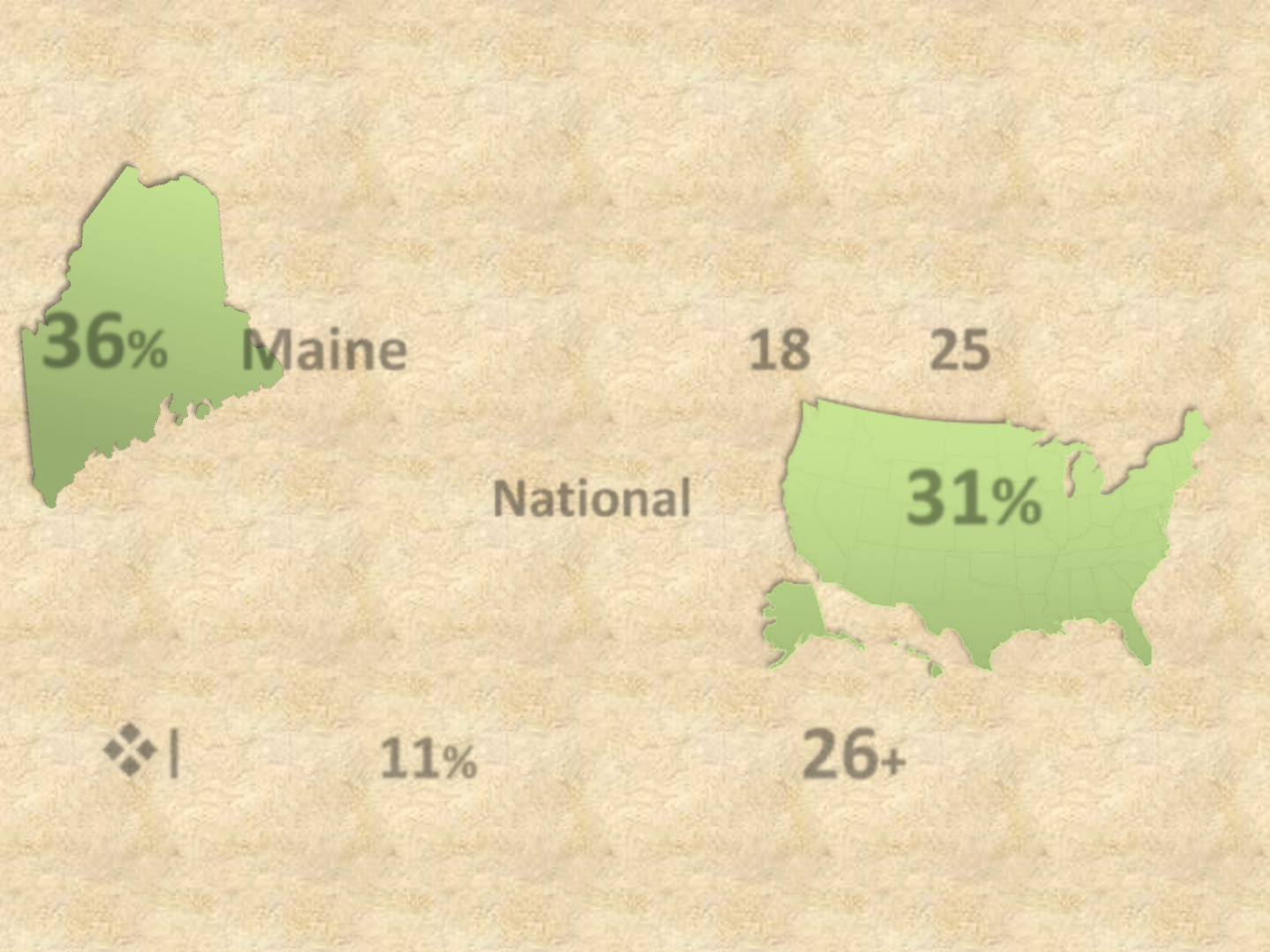
31%
36%
National Comparison
In 2011-12, 11% of residents ages 26+ had used
marijuana in the past year, compared to 8% nationally .
81
of Maine residents between 18 and 25 used
marijuana in the past year in 2011-12 (NSDUH), this was
compared to the National average of
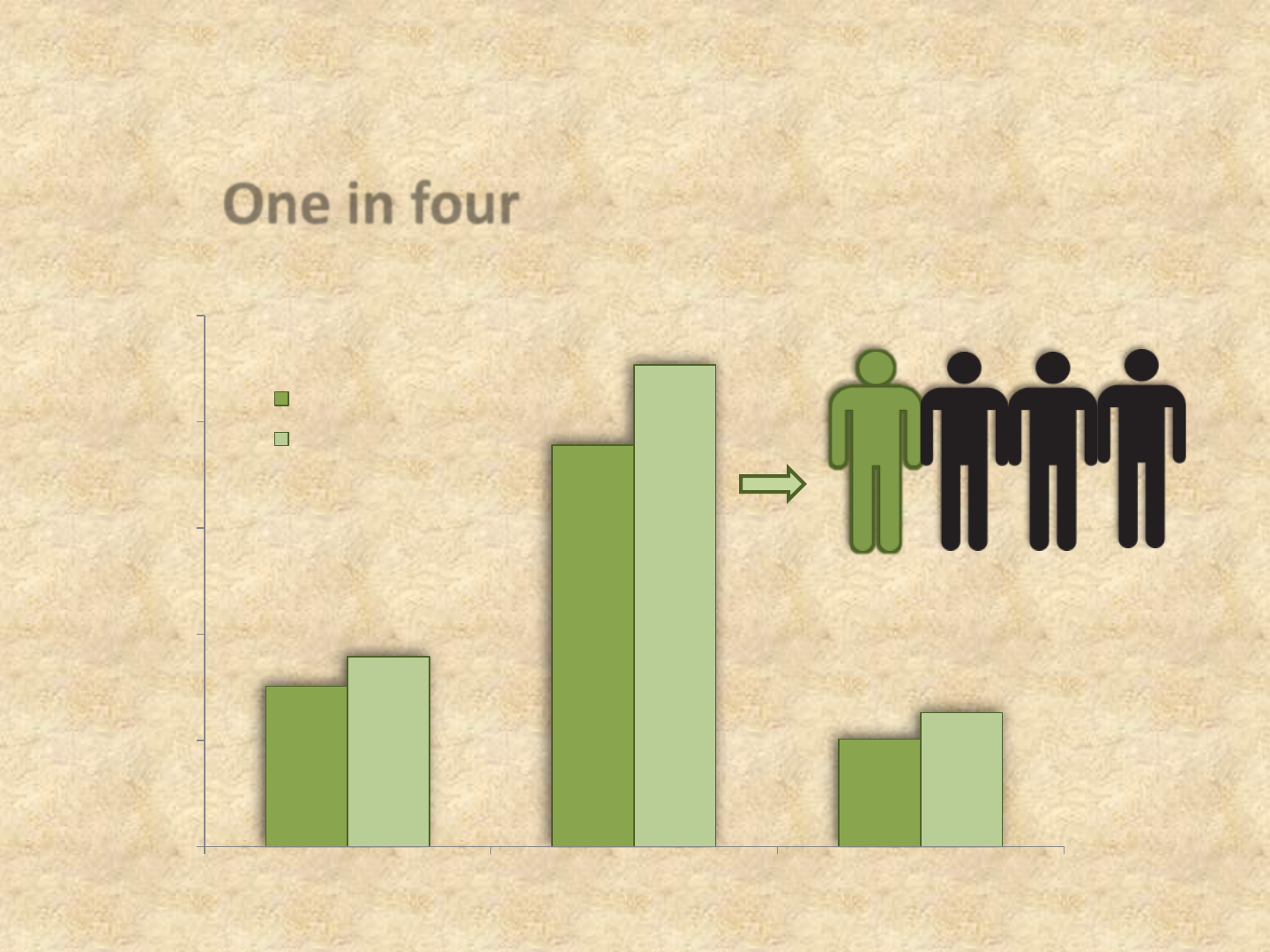
National Comparison
Rates are expected to increase with the inception of medical marijuana.
About One in four (23%) Maine 18 to 25 year olds had
used marijuana in the past month (NSDUH, 2011-12).
82
0%
5%
10%
15%
20%
25%
12 to 17 18 to 25 26 and older
United States
Maine

Initiation of Use
In 2013, 73% of high school students who had ever
used marijuana first did so when they were between the
ages 13 and 16 (MIYHS).
One in Five tried marijuana for the first time before the
age of
13.
83
8%
12%
36%
37%
7%
10 or younger
11 to 12
13 to 14
15 to 16
17 or older
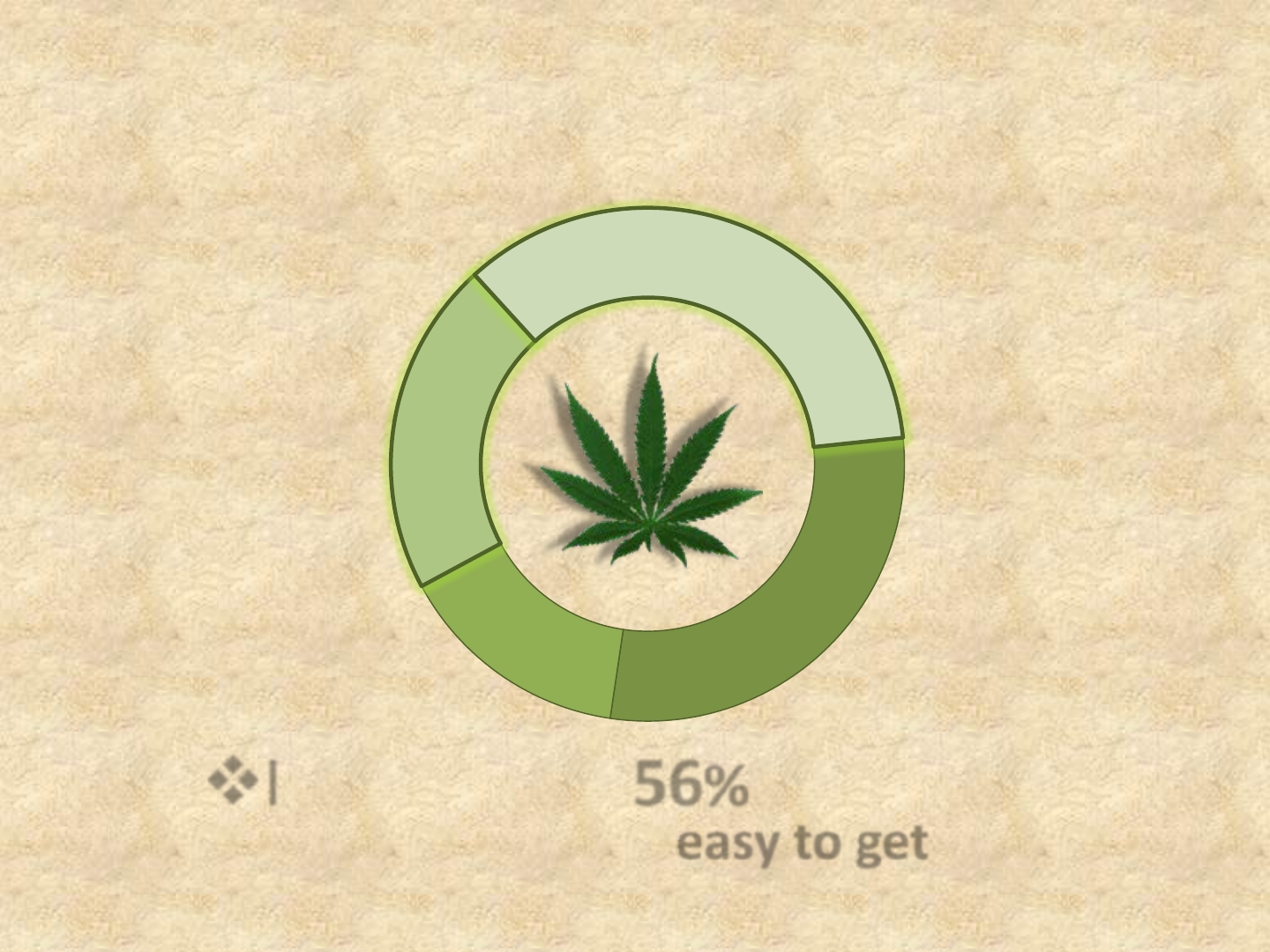
In 2011, over half (56%) of high school
students felt it would be easy to get (MIYHS).
Remained stable since 2009
Availability
84
Very hard,
29%
Sort of hard,
15%
Sort of easy,
21%
Very easy,
35%
2013
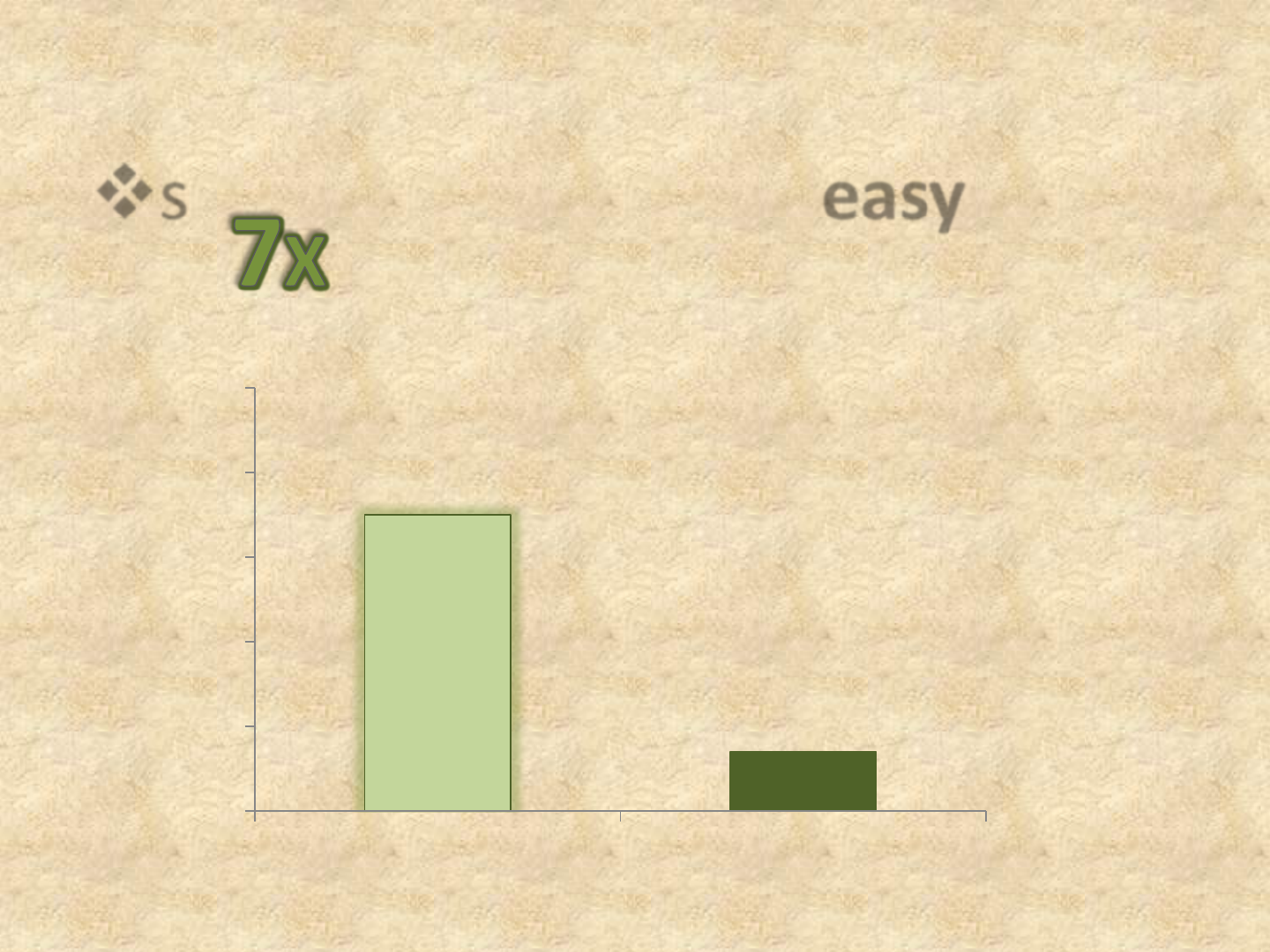
Availability
students who thought marijuana was easy to obtain
were as likely to use marijuana (MIYHS, 2013).
85
35%
7%
0%
10%
20%
30%
40%
50%
Easy to get, smoked MJ
past 30 days
Not easy, smoked MJ past
30 days
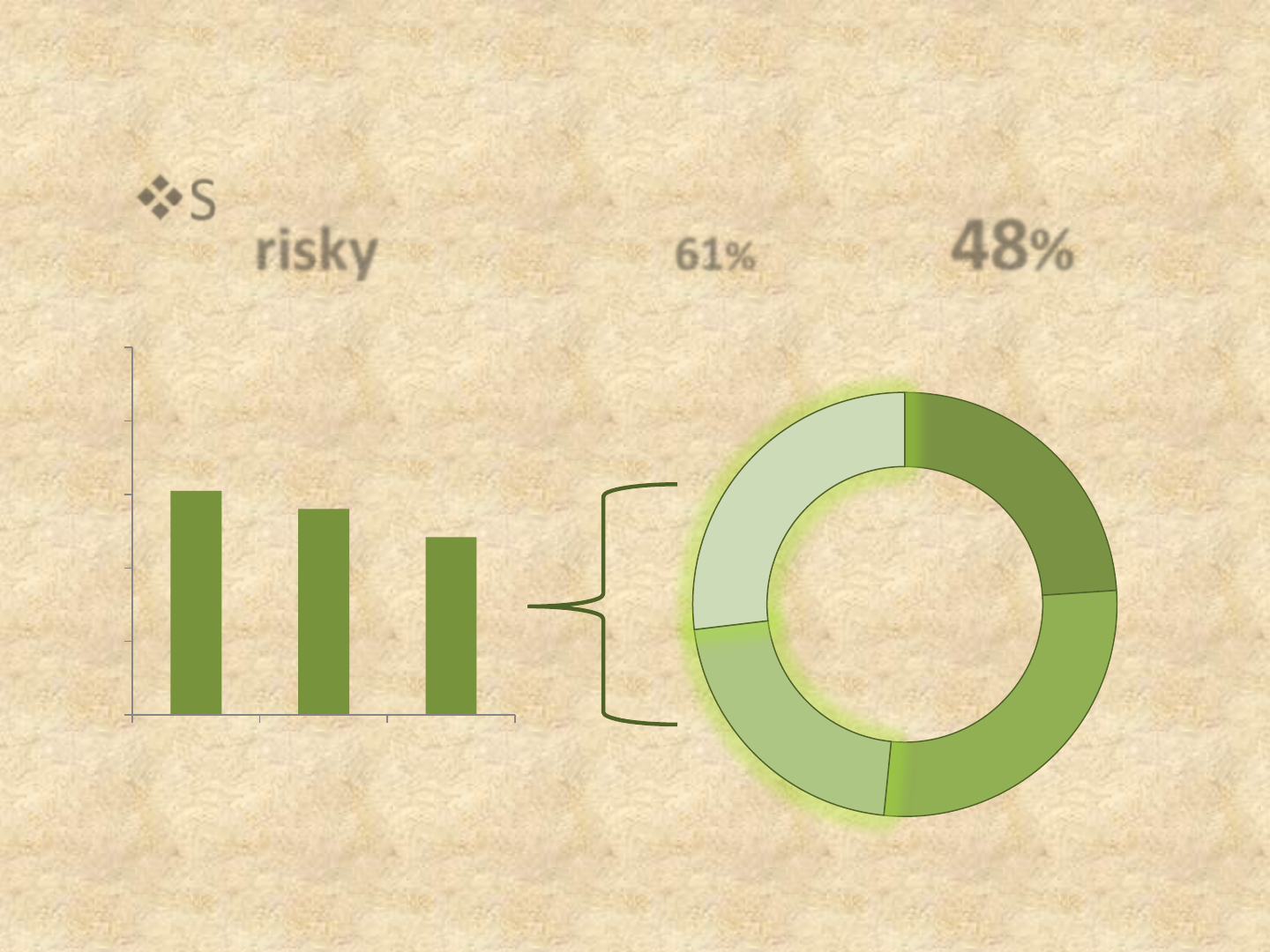
Perception of Harm
Students who thought smoking marijuana regularly
was risky decreased from 61% in 2009 to 48%
in 2013 (MIYHS).
Believed Moderate to
Great Risk
86
61%
56%
48%
0%
20%
40%
60%
80%
100%
2009 2011 2013
No risk
24%
Slight risk
28%
Moderate
risk
21%
Great risk
27%
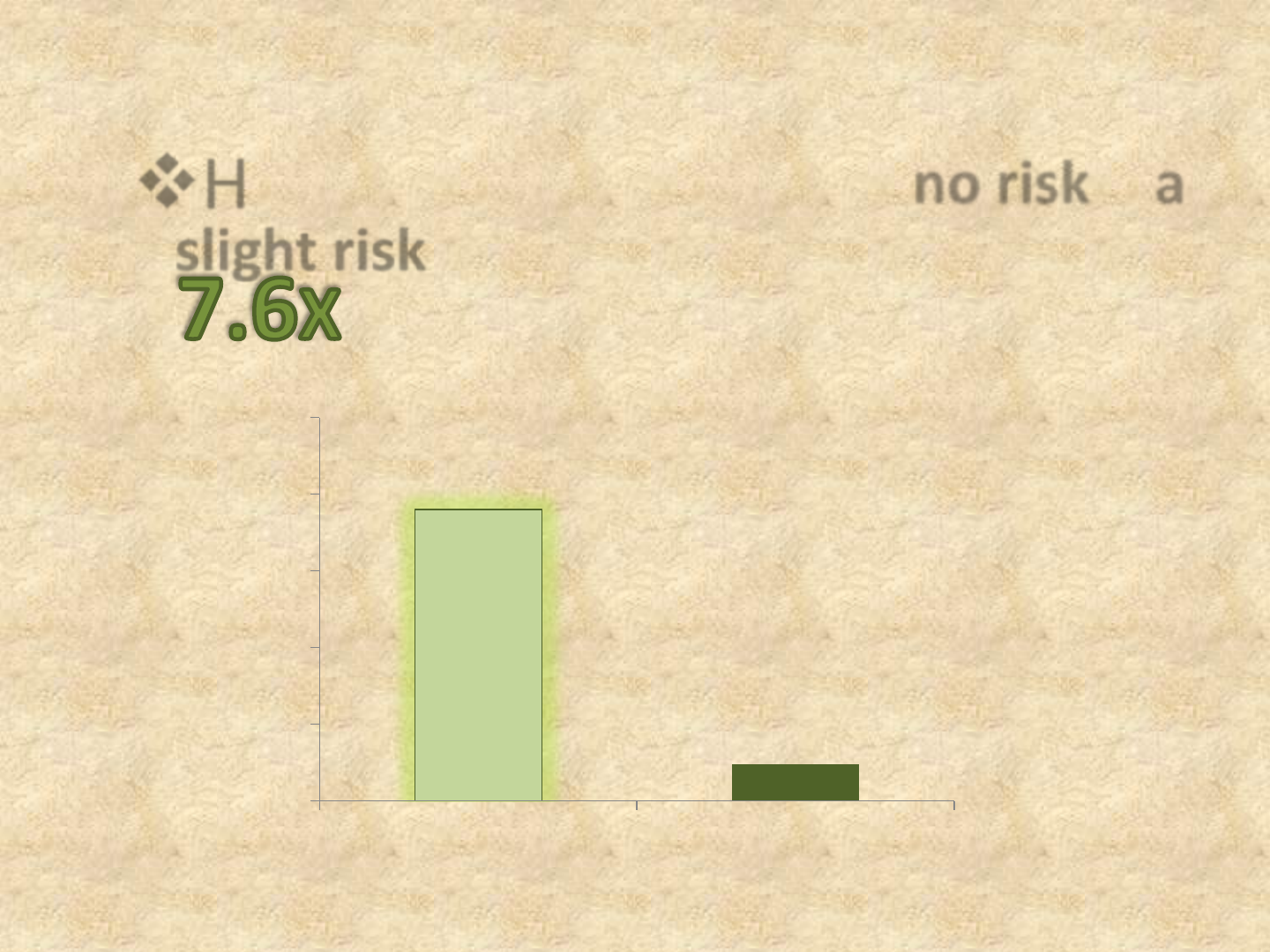
Perception of Harm
High school students who think there is no risk to a
slight risk
in smoking marijuana regularly are
as likely to smoke marijuana (MIYHS, 2013).
87
38%
5%
0%
10%
20%
30%
40%
50%
Don't think risky, smoked
MJ past 30 days
Think risky, smoked MJ
past 30 days
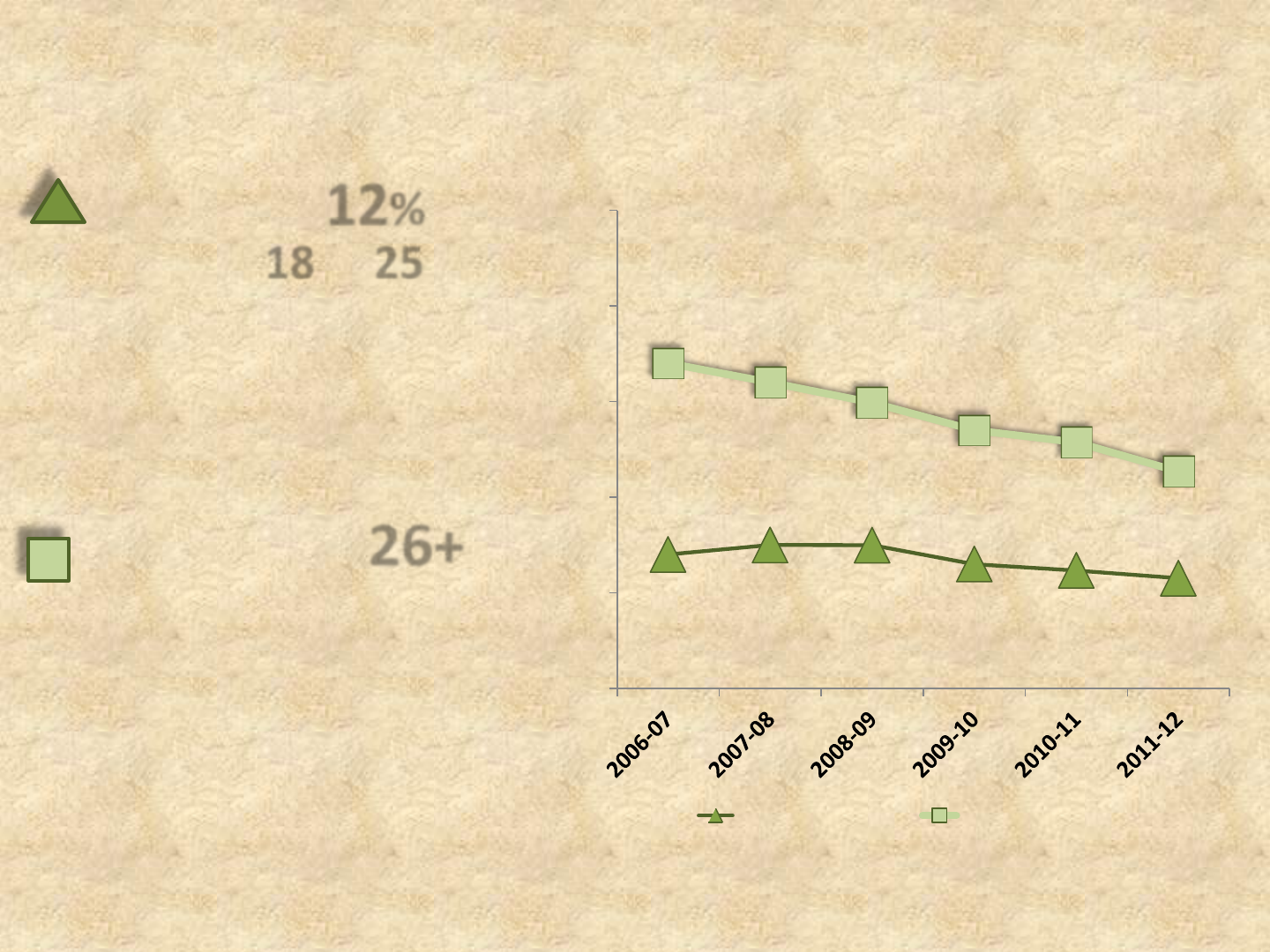
Perception of Harm
In the 2011-12, 12% of
adults ages
18 to 25
perceived a great risk in
smoking marijuana once per
month (NSDUH).
Among adults aged 26+,
perceptions of
risk have
decreased by 11 percentage
points since 2006-07.
88
14%
15%
15%
13%
12%
12%
34%
32%
30%
27%
26%
23%
0%
10%
20%
30%
40%
50%
18-25 year olds 26+ year olds
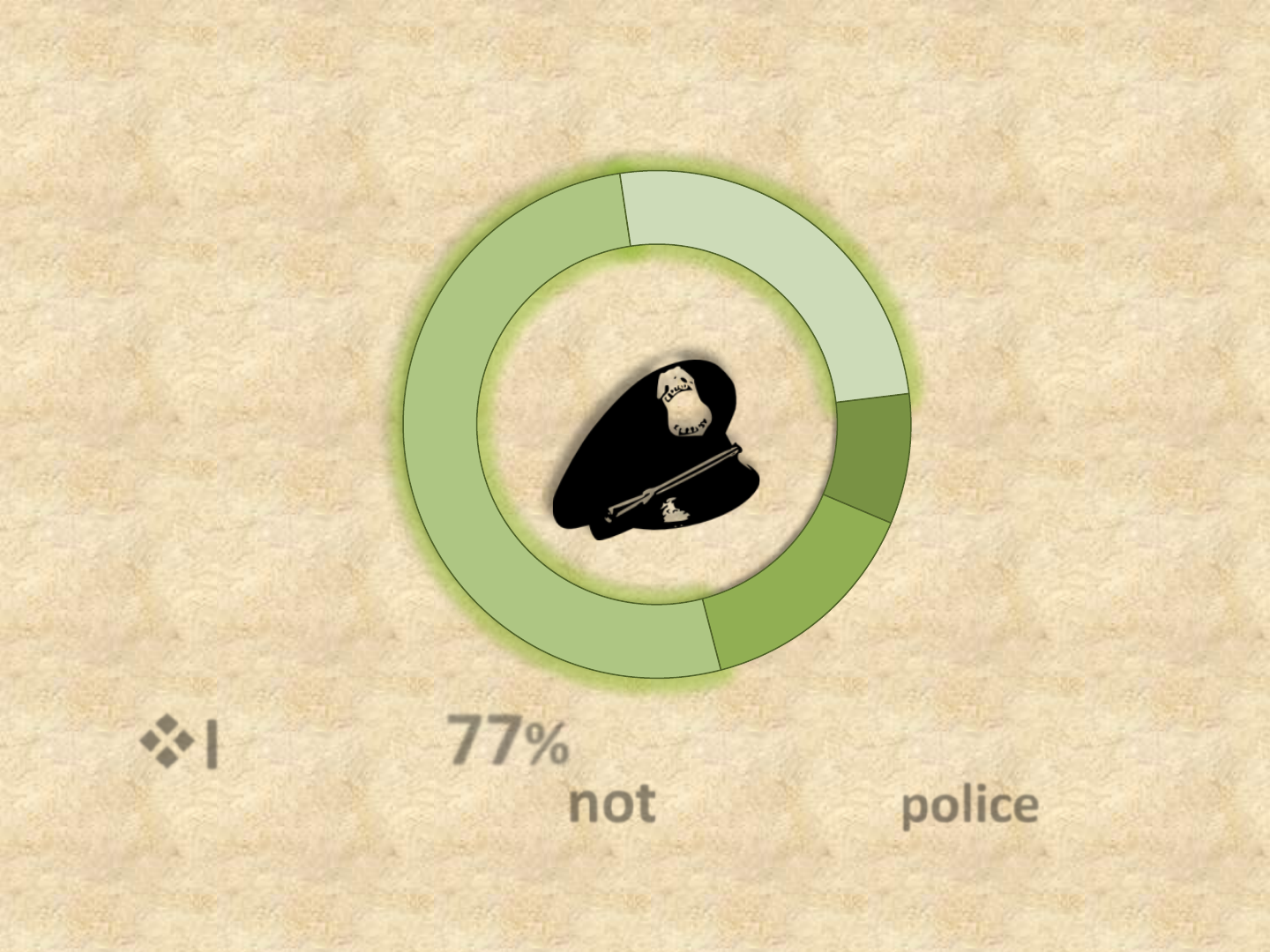
Perception of Enforcement
In both 2013, 77% of high school students felt kids in
the community would not be caught by police for
smoking marijuana (MIYHS).
89
Definitely yes
8%
Probably yes
15%
Probably not
52%
Definitely not
25%
2013
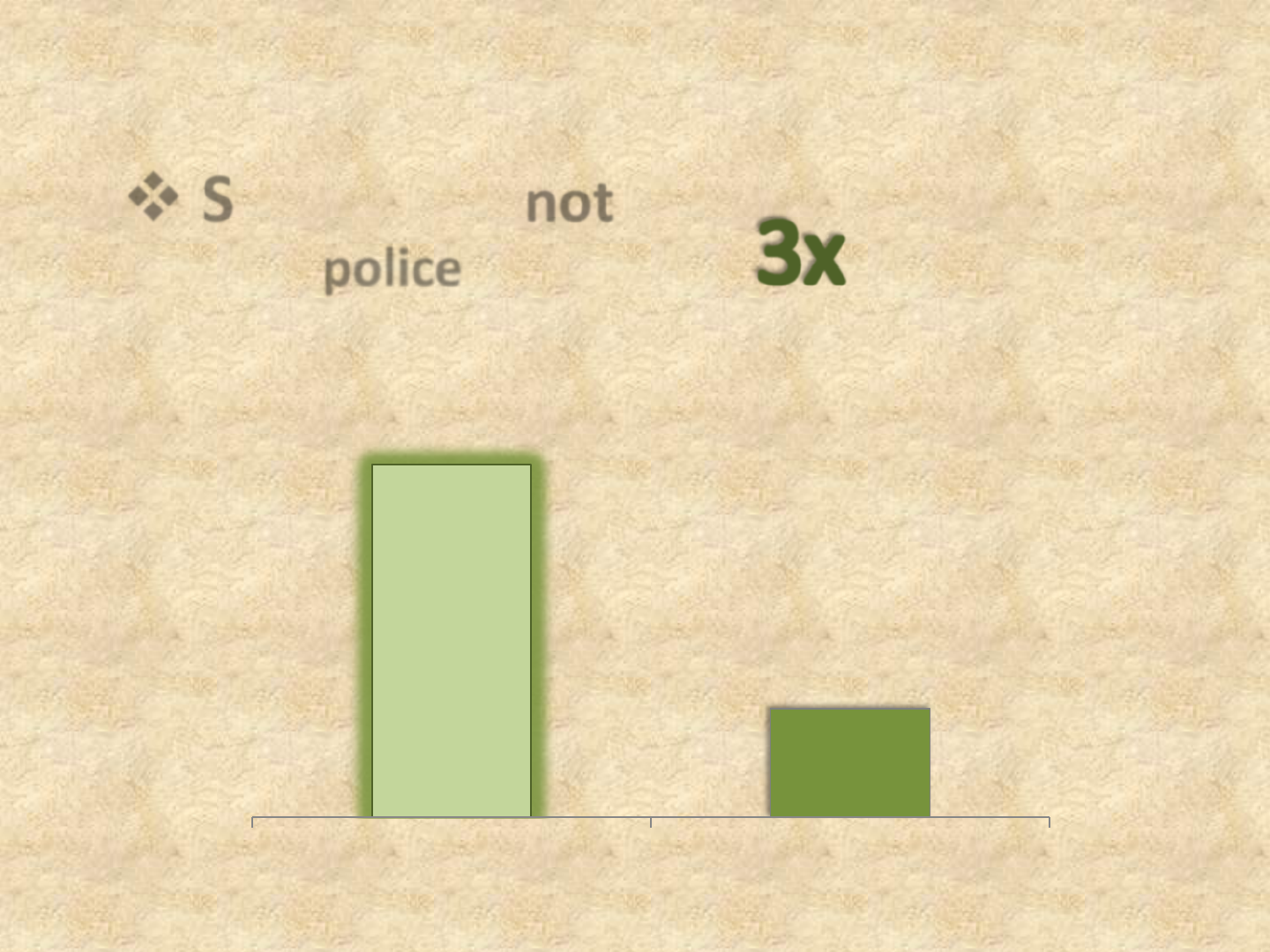
Perception of Enforcement
Students who did not think that they would be caught
by the police were more than 3xas likely to smoke
marijuana.
90
26%
8%
No, caught by police, yes
smoked MJ past 30 days
Yes, caught by police, yes
smoked MJ past 30 days
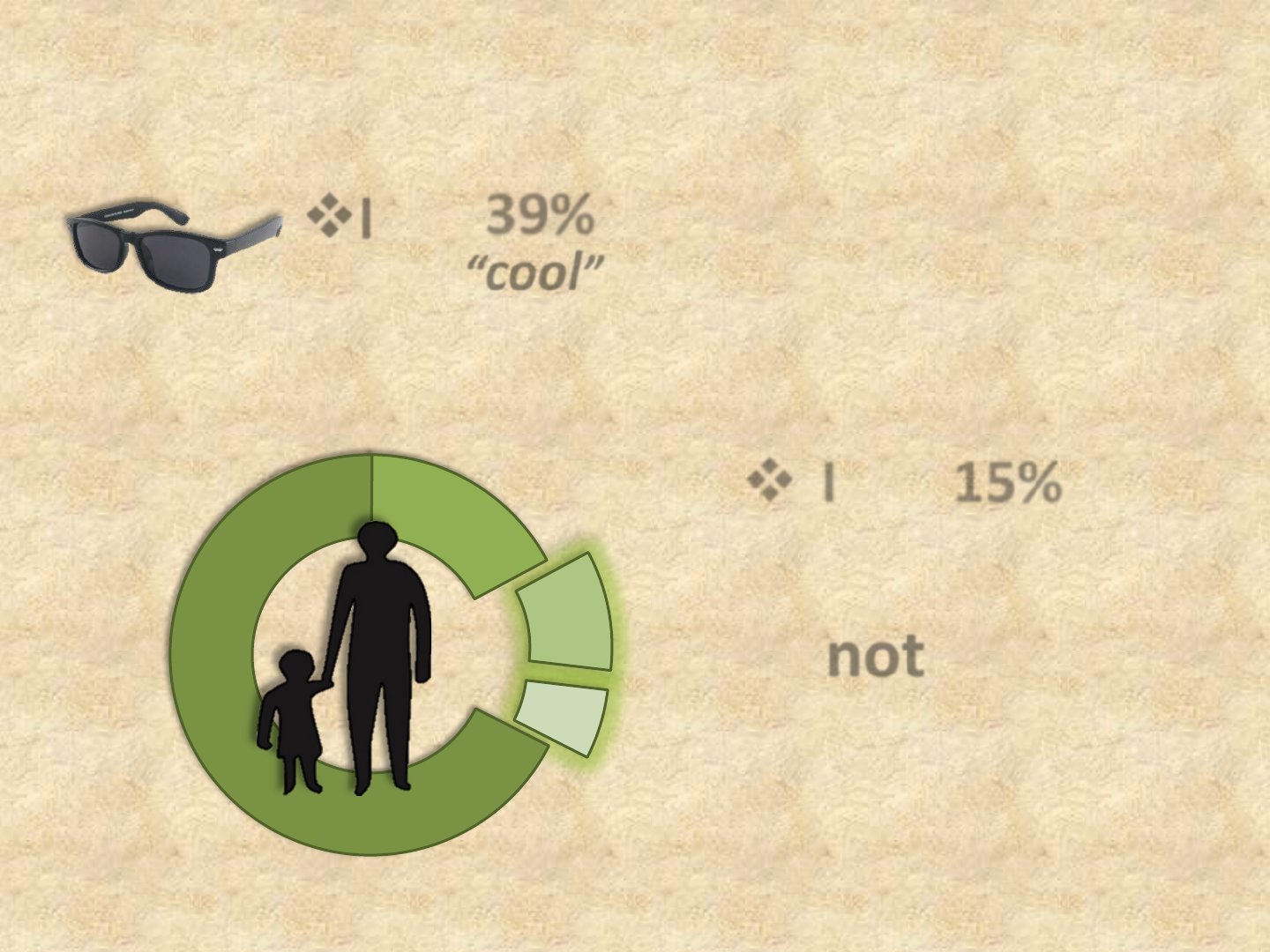
Very wrong
68%
Wrong
17%
A little bit
wrong
10%
Not wrong
at all
5%
In 2013, 39% of students thought they would be
seen as
“cool” if they smoked marijuana (MIYHS).
In 2013, 15% of
students reported that
their
parents would
not feel it would
be wrong for them to
smoke marijuana
(MIYHS).
Community and Social Norms
91
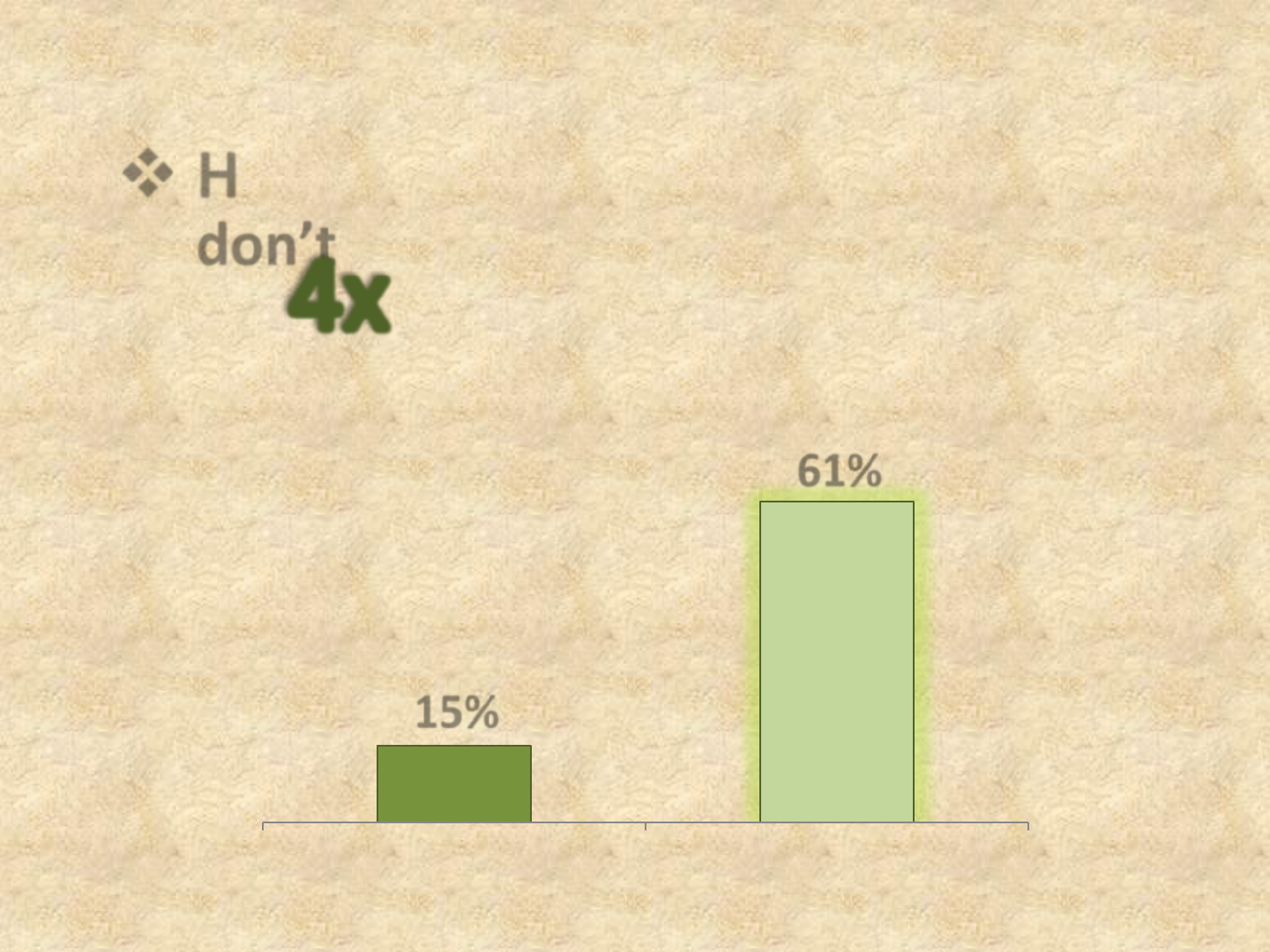
Community and Social Norms
High school students who believe their parents
don’t feel it is wrong for them to smoke marijuana
were 4x as likely to use (MIYHS, 2011).
92
15%
61%
Yes, my parents think it's wrong, yes
smoked MJ past 30 days
No, my parents don't think it's
wrong, yes I smoked past 30 days
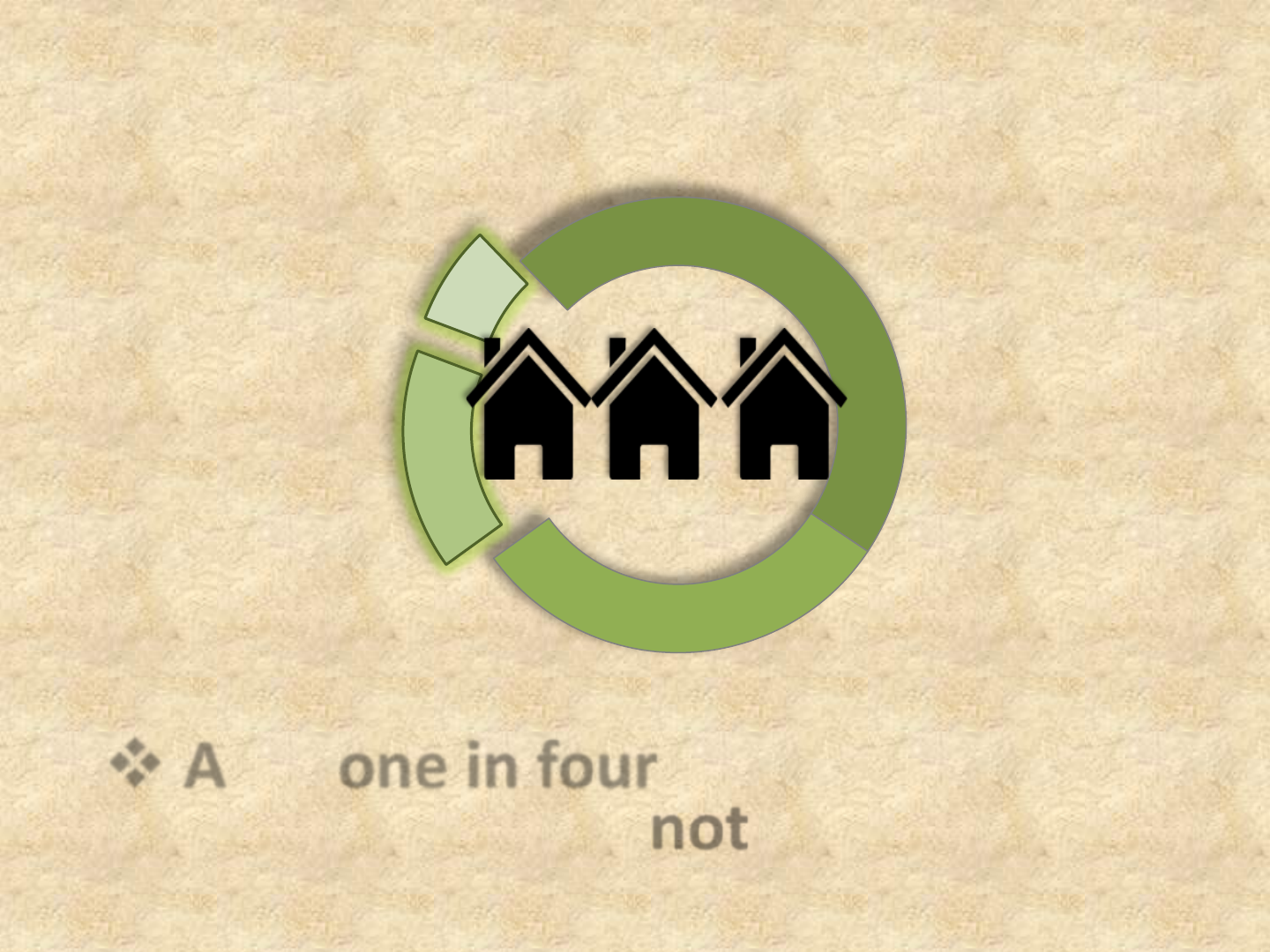
Almost one in four students thought that adults
in their community would not feel it would be wrong to
smoke marijuana (MIYHS, 2011).
Very wrong,
47%
Wrong, 31%
A little bit
wrong,
16%
Not wrong at
all,
7%
Community and Social Norms
93
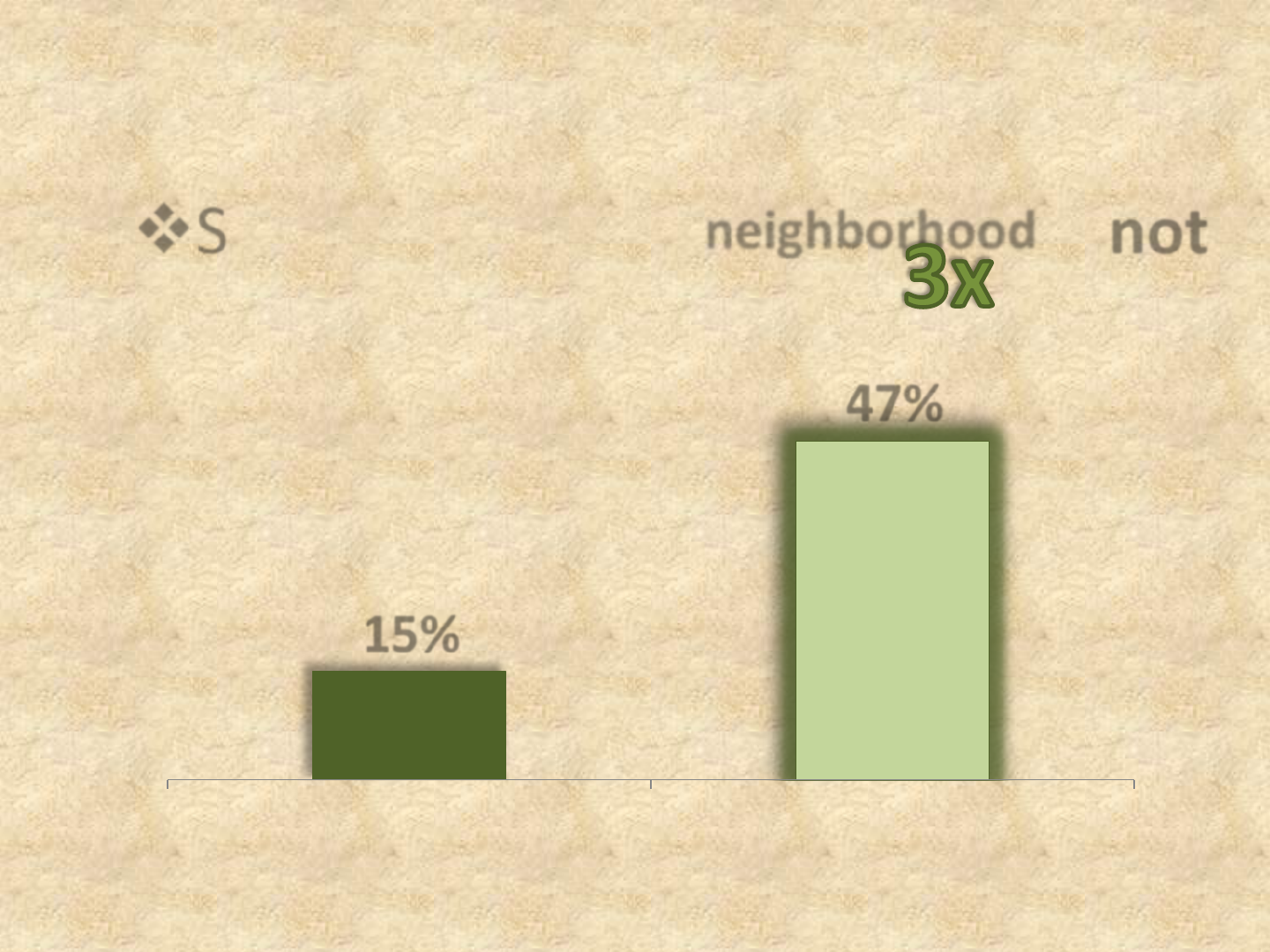
15%
47%
Yes neigbors think it's wrong, yes
smoked MJ past 30 days
No neighbors don't think it's wrong, yes
smoked MJ past 30 days
Students who think adults in their neighborhood do not
think it is wrong for kids to use marijuana are as likely to
use it as their peers
(MIYHS, 2011).
Community and Social Norms
94
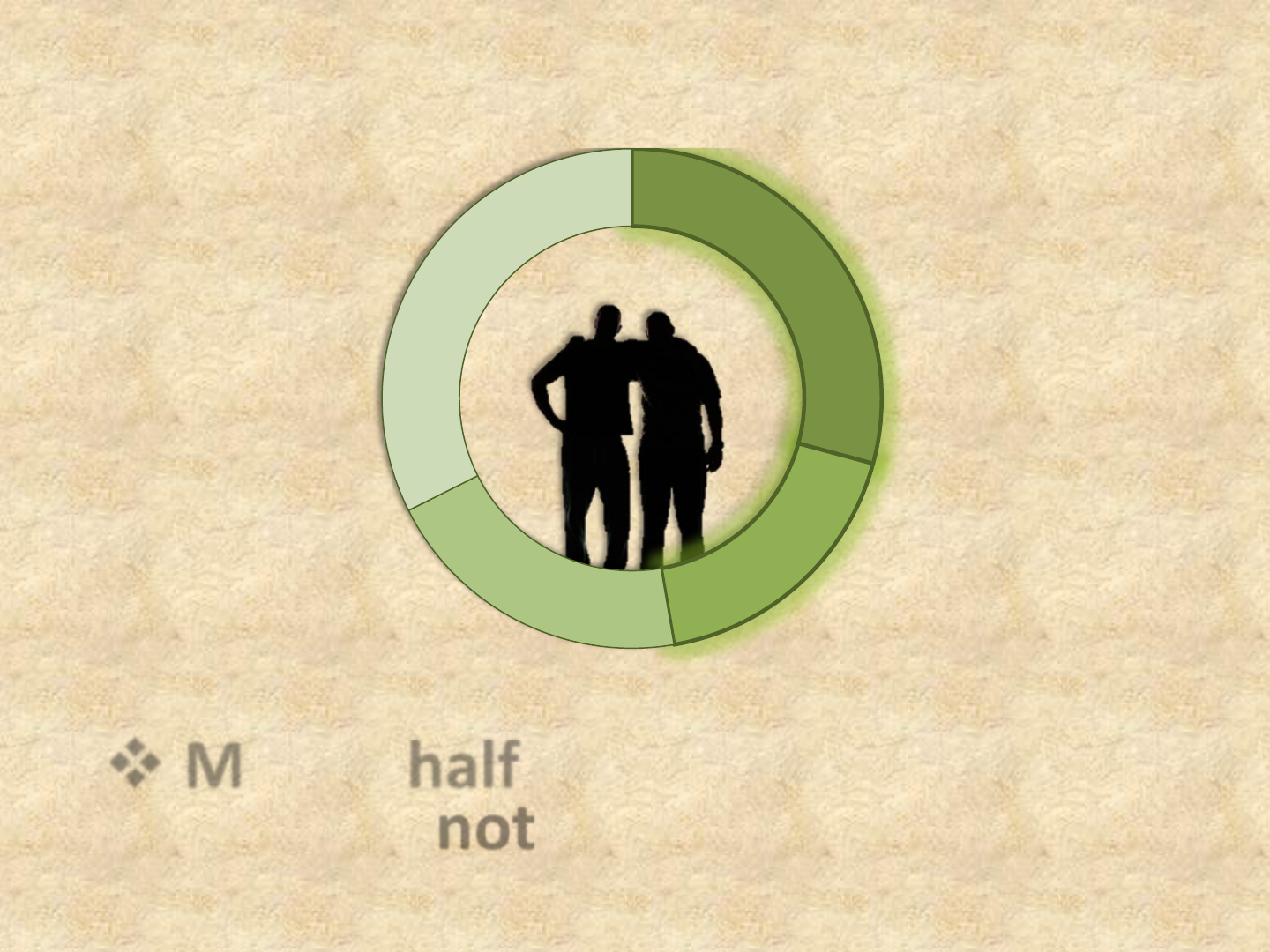
95
Very wrong
29%
Wrong
18%
A little bit
wrong
20%
Not wrong at
all
33%
Community and Social Norms
More than half (53%) of students thought that their
friends would not feel it would be wrong to smoke
marijuana (MIYHS, 2013).
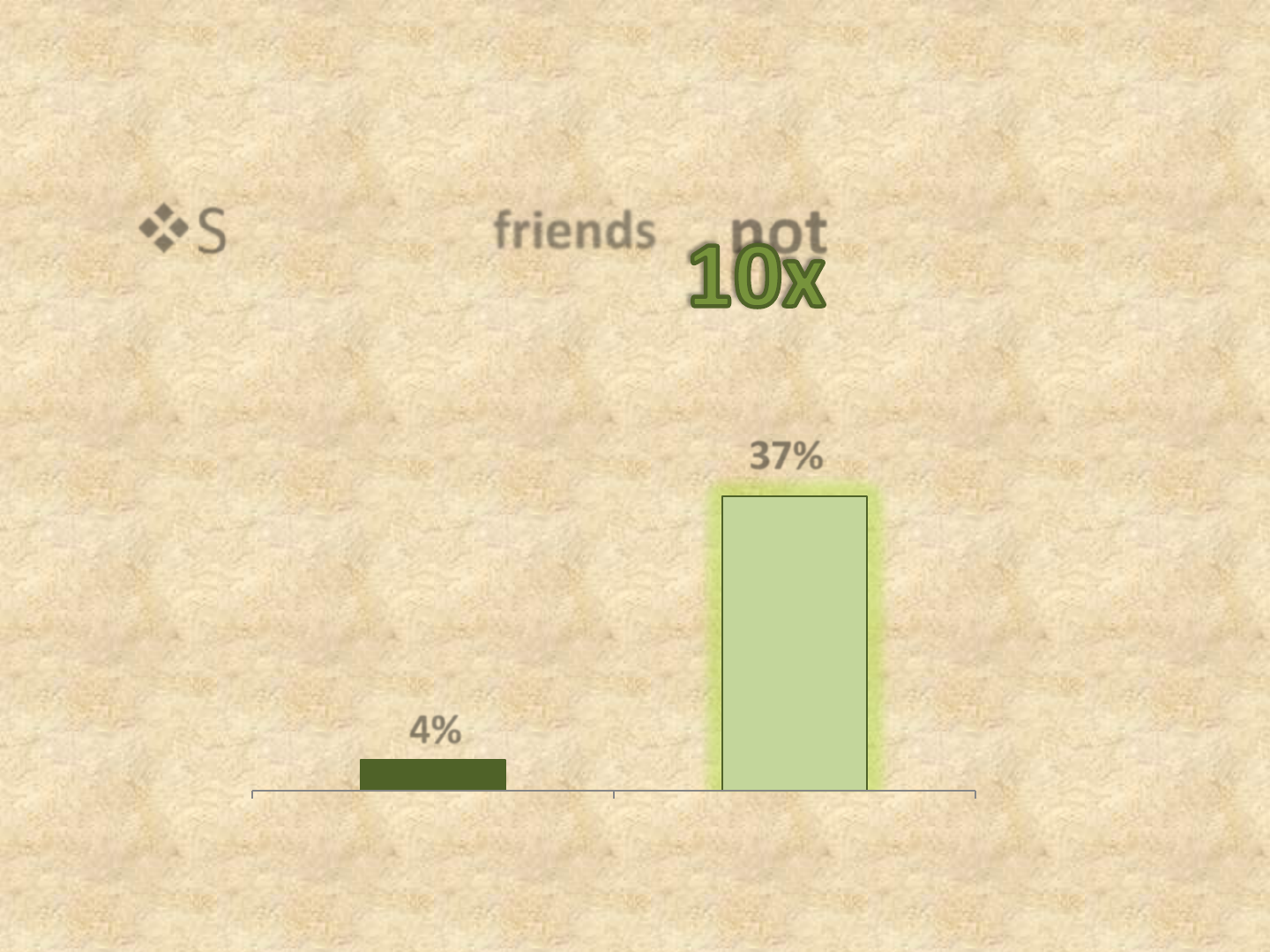
Students who think friends do not think it is wrong for
them to use marijuana are almost
as likely to use it as their
peers
(MIYHS, 2013).
Community and Social Norms
96
4%
37%
Yes, my friends think it's wrong,
yes smoked MJ past 30 days
No, my friends don't think it's
wrong, yes I smoked past 30 days
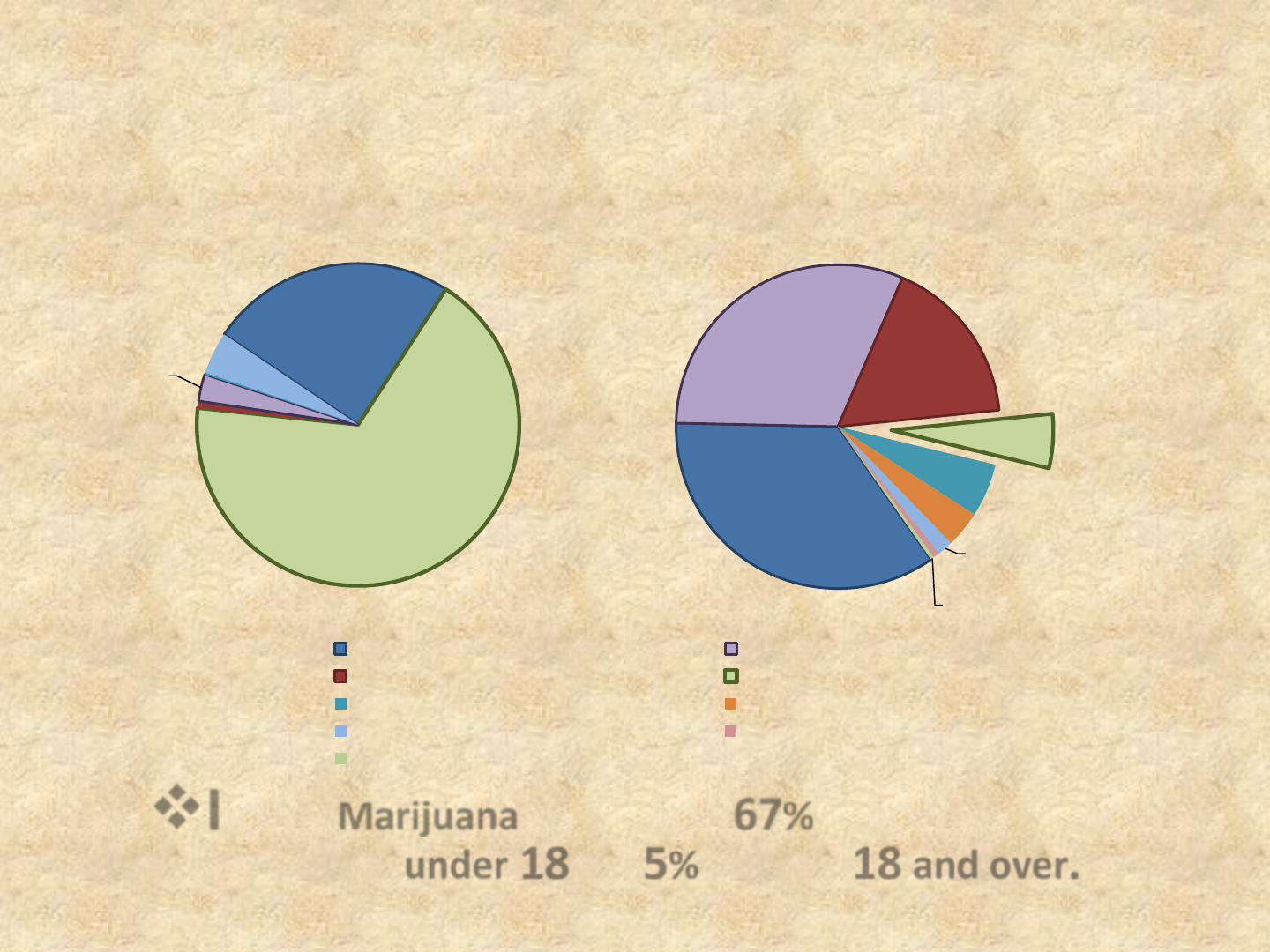
35%
31%
17%
5%
5%
4%
2%
1%
0%
18 and over
Alcohol Synthetic opioids
Heroin/morphine Marijuana
Methadone/buprenorphine Cocaine/crack
Other drugs Benzodiazepines
Bath Salts
Primary Drug Admissions (TDS, 2013)
97
In 2013, Marijuana accounted for 67% of primary treatment
admissions for
under 18 and 5% for adults 18 and over.
25%
67%
1%
3%
0%
4%
Under 18
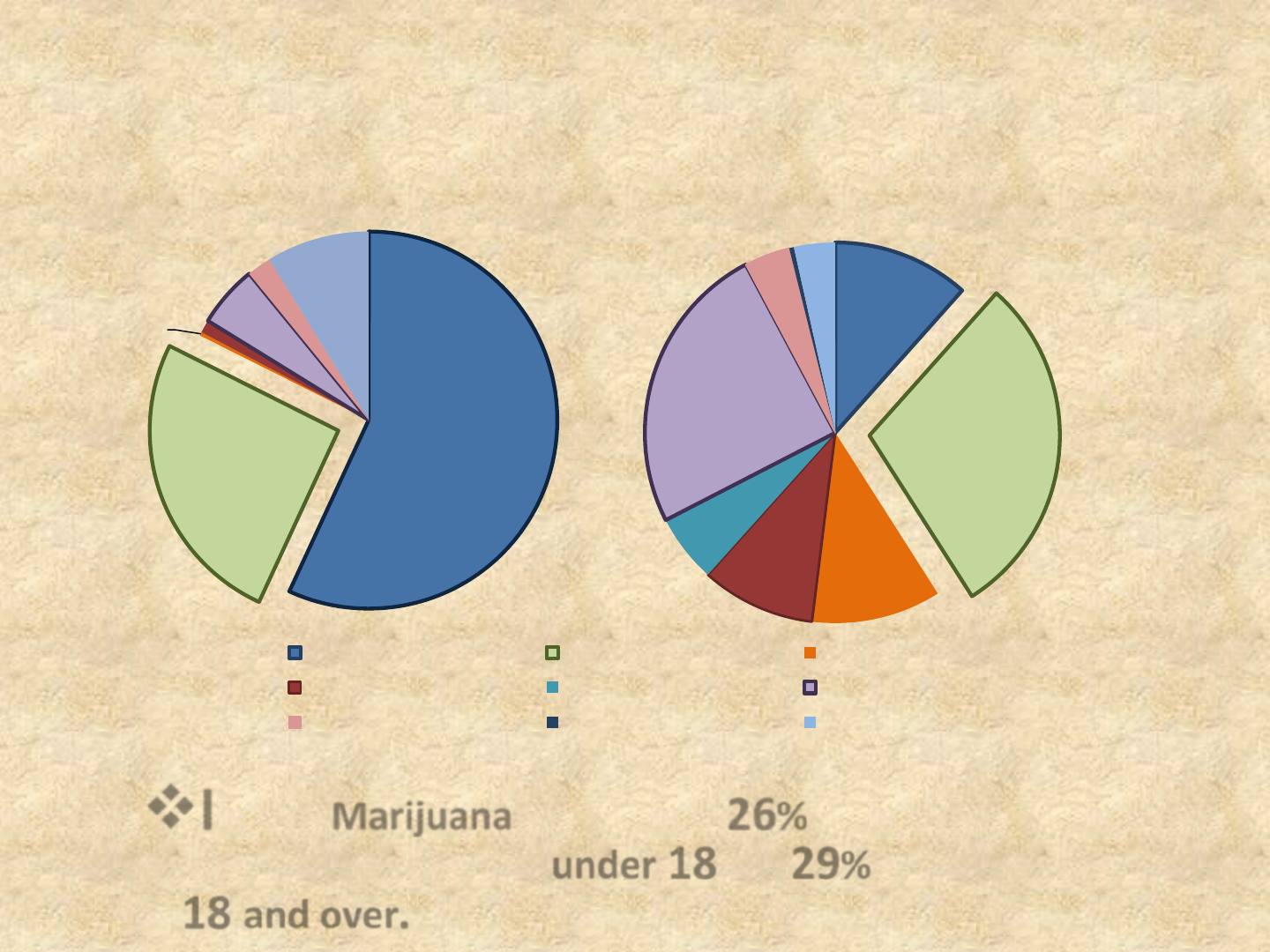
98
12%
29%
11%
10%
6%
25%
4%
0%
3%
18 and over
Alcohol Marijuana Crack/Cocaine
Heroin Methadone Synthetic opioids
Benzodiazepines Bath salts Other drugs
57%
26%
0%
1%
5%
2%
9%
Under 18
Secondary Drug Admissions (TDS, 2013)
In 2012, Marijuana accounted for 26% of secondary
treatment admissions for
under 18 and 29% for adults
18 and over.
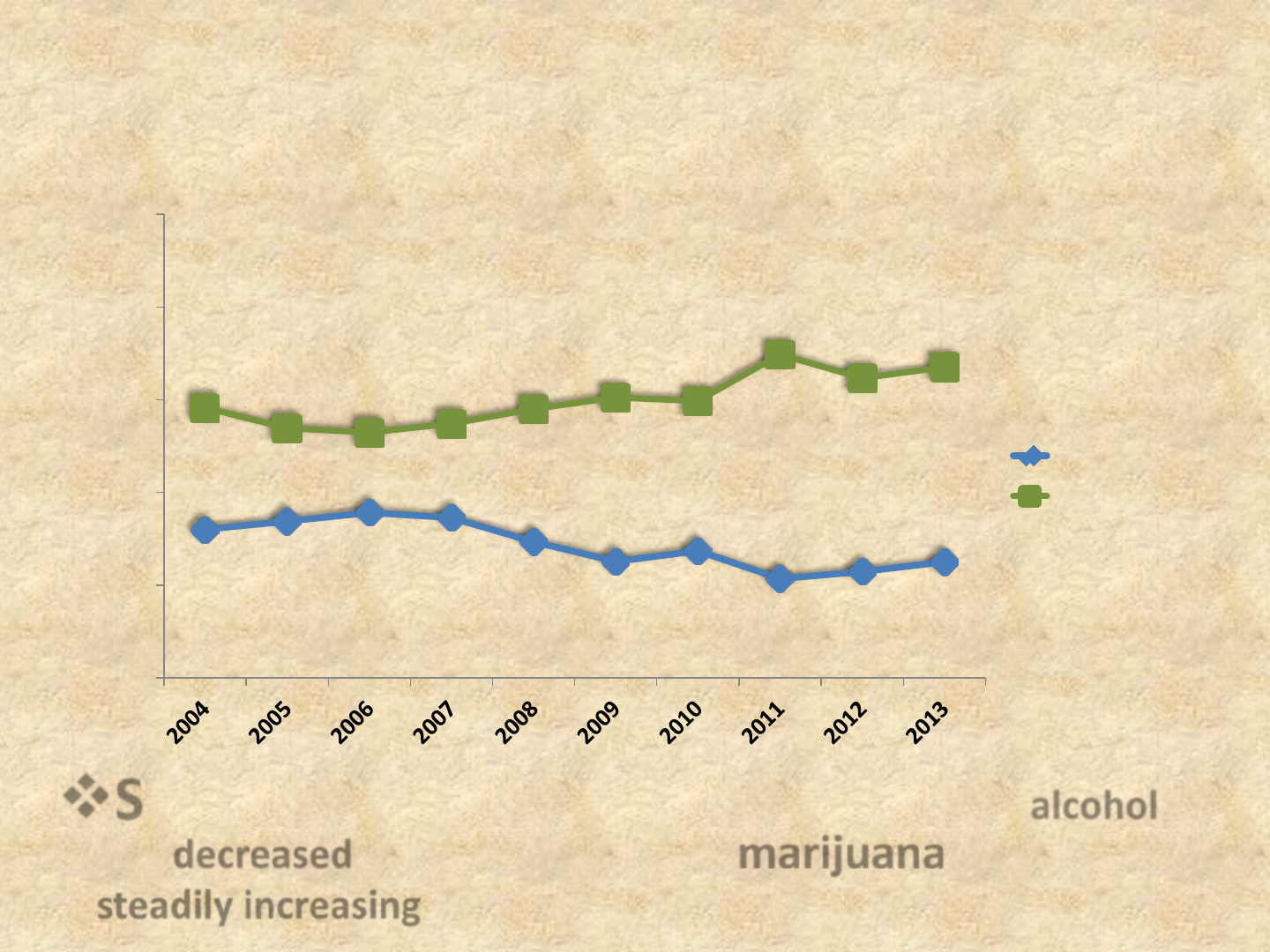
Percentage of Primary Admissions for 18 and Under
by Substance
(TDS, 2004-2013)
99
Since 2006, as the proportion of primary admissions related to alcohol
have
decreased and admissions related to marijuana have been
steadily increasing.
0%
20%
40%
60%
80%
100%
ALCOHOL
MARIJUANA

Marijuana Use
and Prevention:
What can parents do to help
prevent Marijuana use ?
What can the community do
to help prevent Marijuana use?
100

Parents
Talk to your child about MJ use
Talk to your child about marijuana BEFORE you
suspect they are experimenting. Studies show that
youth are most likely to initiate marijuana use
between the ages of 13 and 15 - and during this
time parents have the most influence over their
behavior. After age 15, teens tend to base their
decisions more on peer influences.
Before you talk to your teen, make sure you speak
their language. Visit the virtual teen room to learn
more:
http://www.maineparents.net/Teenroom/index.shtml
101

Parents:
Talk to your child about MJ use
If you think your child has been using marijuana, ask
them about it immediately. Kids say that losing their
parents' respect and trust are the most important
reasons not to use drugs.
Help your child to understand ALL of the
consequences of marijuana use – including
physical, legal, learning, and future success.
102

Parents
Tips for talking with your child
• Encourage your teen to tell you how he or she
thinks and feels about the issue you're discussing.
• If you hear something you don't like, try not to
respond with anger. Instead, take a few deep
breaths and acknowledge your feelings in a
constructive way.
• If you show respect for your teen's viewpoint, he or
she will be more likely to listen to and respect yours.
103

Parents
Tips for talking with your child
• Your kids may know more about marijuana than
you expect. Be prepared; educate yourself and
listen.
• Encourage conversation including talking about his
or her interests.
• Listen without interruption and control your
emotions.
104

Parents
Tips for talking with your child:
• Give your child a chance to teach you something
new.
• Active listening paves the way for conversations
about topics that concern you.
• Ask open-ended questions and avoid questions
with a simple yes or no answer.
105

Parents
Tips for talking with your child:
• What if they ask “did you use?”
• Tell the truth.
• Don’t glamorize or detail.
• Focus on your child’s present and future
decisions.
• If you didn’t use explain why and what
you saw with those who did.
106

Parents
Signs your child may be using
Marijuana produces a wide variety of signs
and symptoms. Some acute symptoms of
use are:
Dry mouth Intense food cravings Red eyes
Panic attacks Sweaty palms Dazed/slow
demeanor
107

Parents
Signs your child may be using
• Withdrawn, depressed, tired, and careless about personal
grooming.
• Hostile and uncooperative; and frequently breaks curfews.
• Relationships with family members have deteriorated.
• Hanging around with a new group of friends.
• Grades have slipped, and his or her school attendance is
irregular.
• Lost interest in hobbies, sports, and other favorite activities.
• Eating or sleeping patterns have changed; he or she is up
at night and sleeps during the day.
• Has a hard time concentrating.
108

Community Members
• Become a member of your local Healthy
Maine Partnership.
• Learn more about the risks of marijuana use.
• Educate others about the risks of marijuana
use.
• Understand what is happening
in your community and
get involved in spreading
awareness.
109

SAMHS Resources
• Drug fact sheets:
http://www.maine.gov/dhhs/samhs/osa/irc/drugfact
sheets.htm
Adolescent Risk with Marijuana Use (pdf)
Marijuana and Driving (pdf)
Marijuana Use in Maine --CESN, 2012 (pdf)
NASADAD Marijuana Fact Sheet (pdf)
• Find Out More, Do More: Maine Parents page:
www.maineparents.net
• Teen Room
www.maineparents.net/Teenroom/index.shtml
110

Research Findings
These slides contain
research findings of the
originators, should you need
the articles, please contact
your SAMHS project officer.
111

COMMENTS?
112
